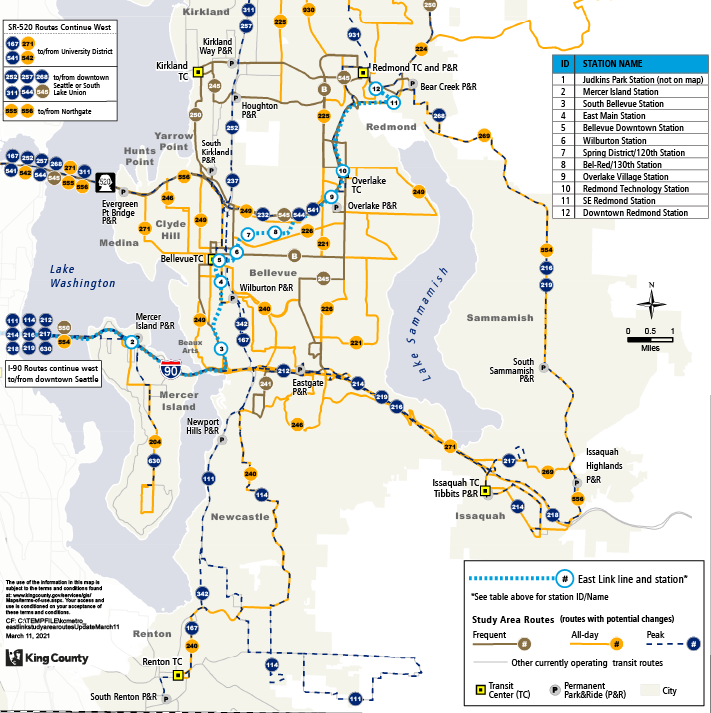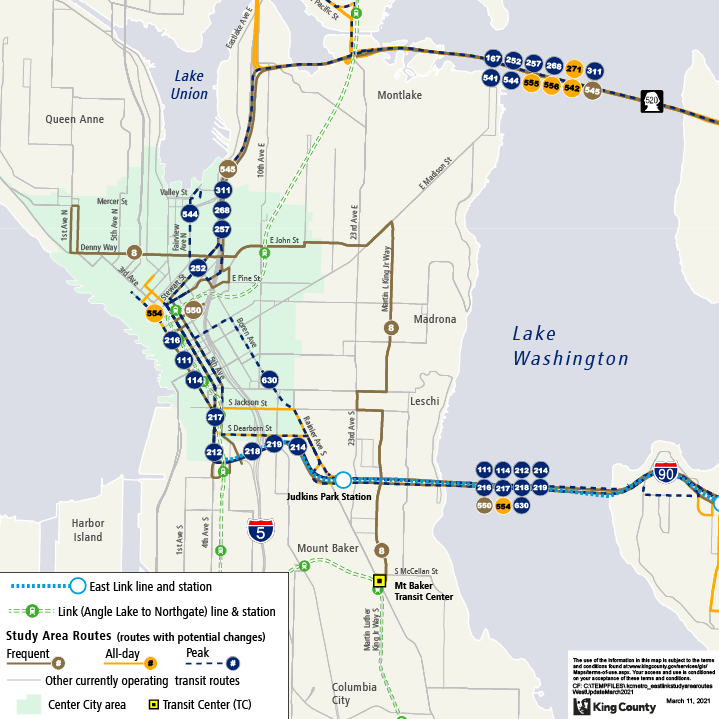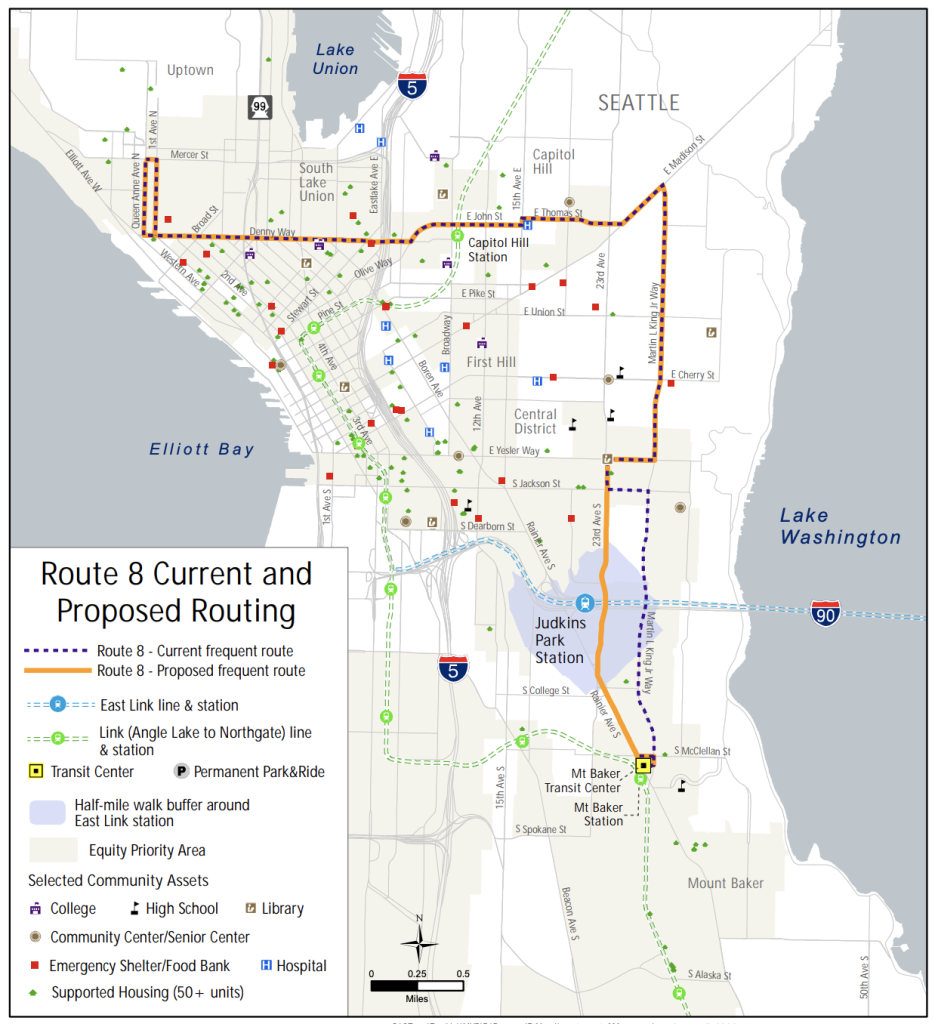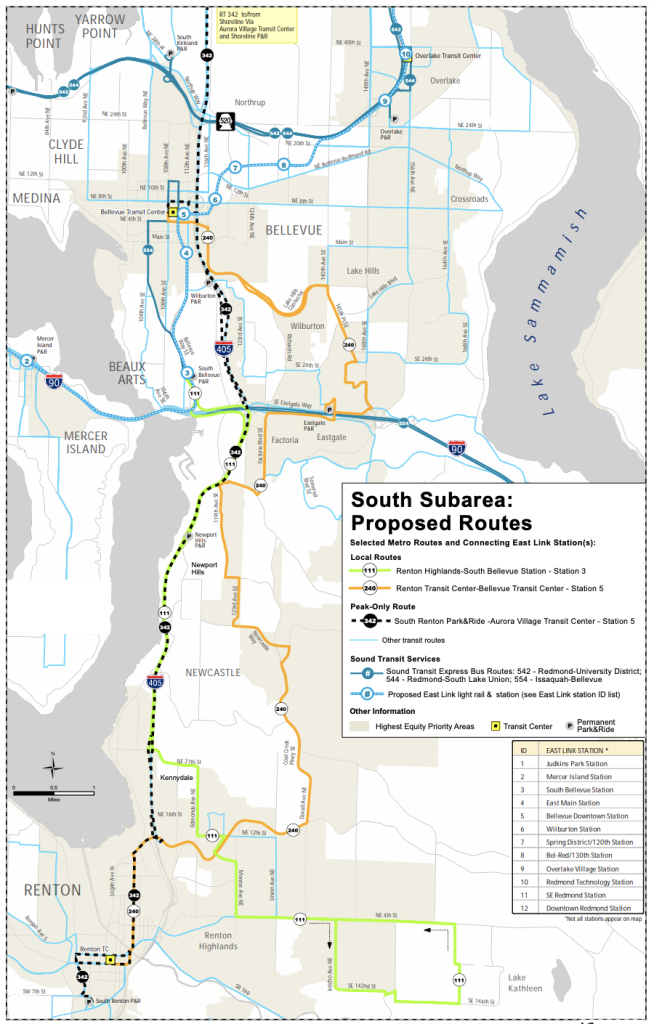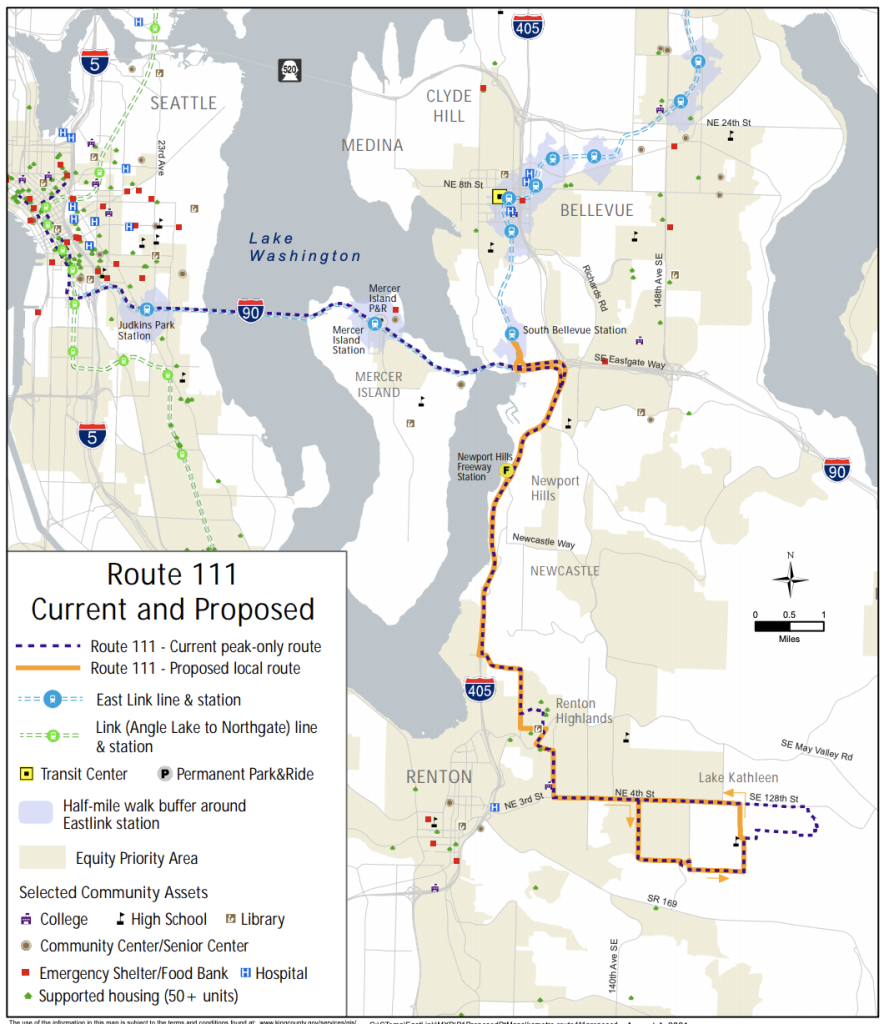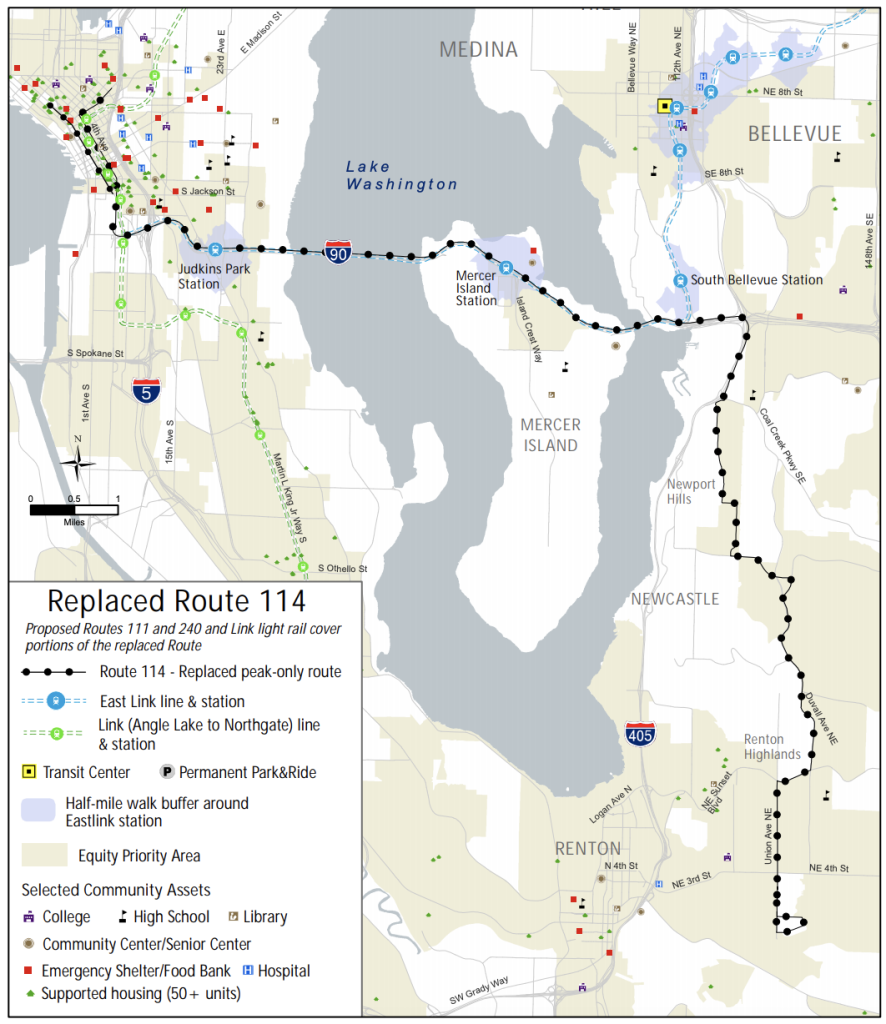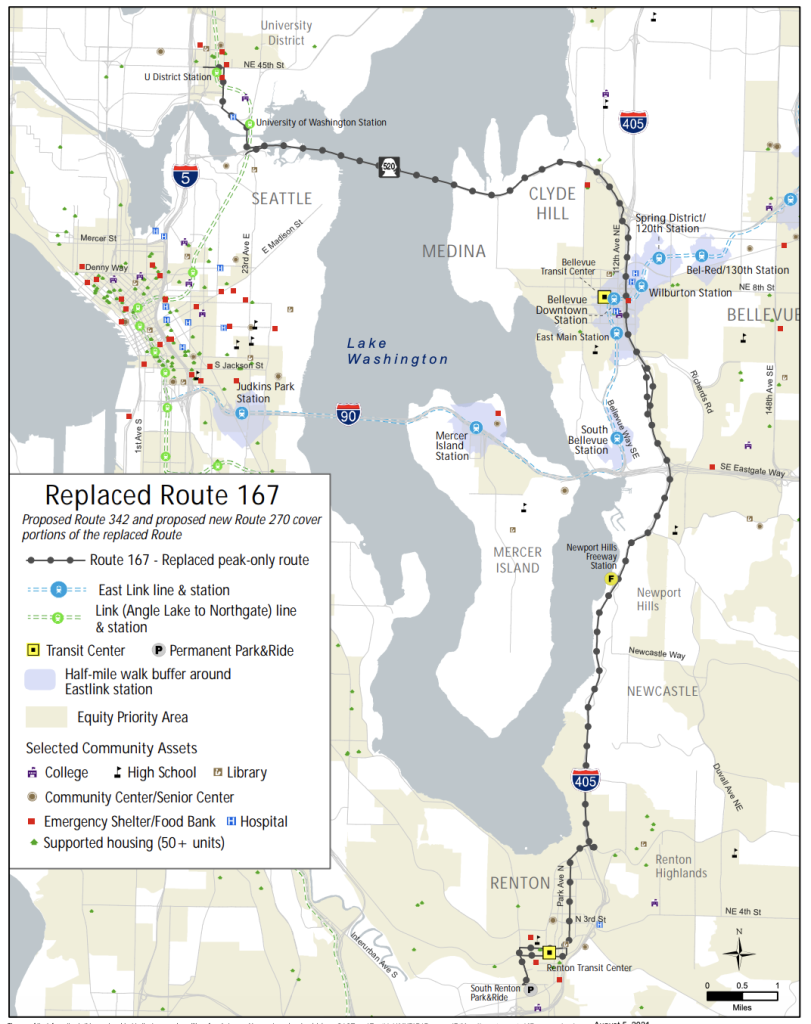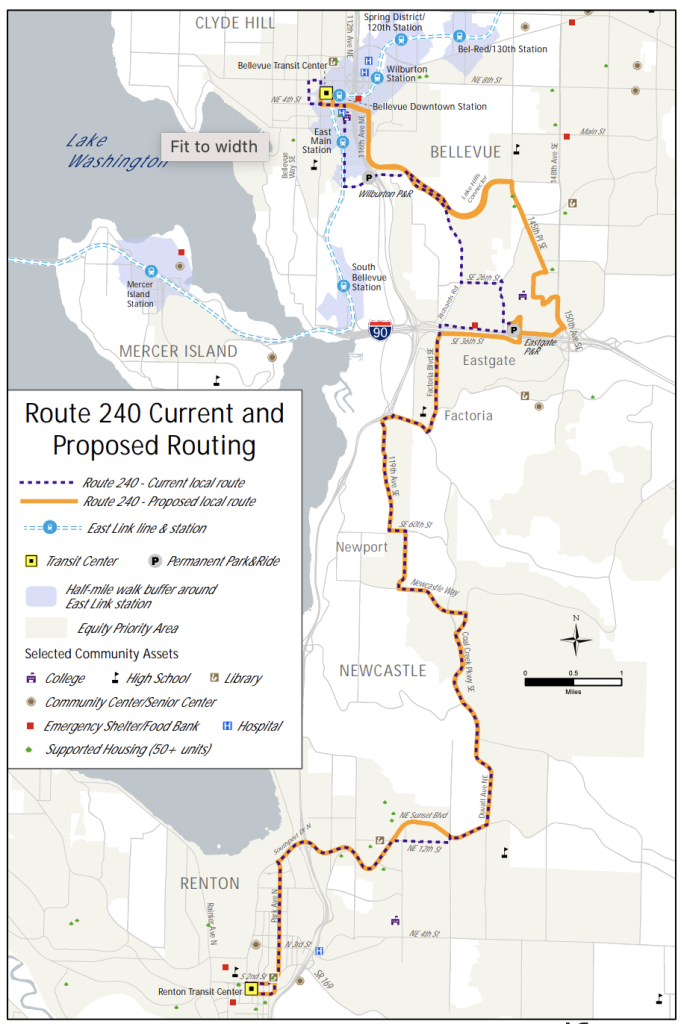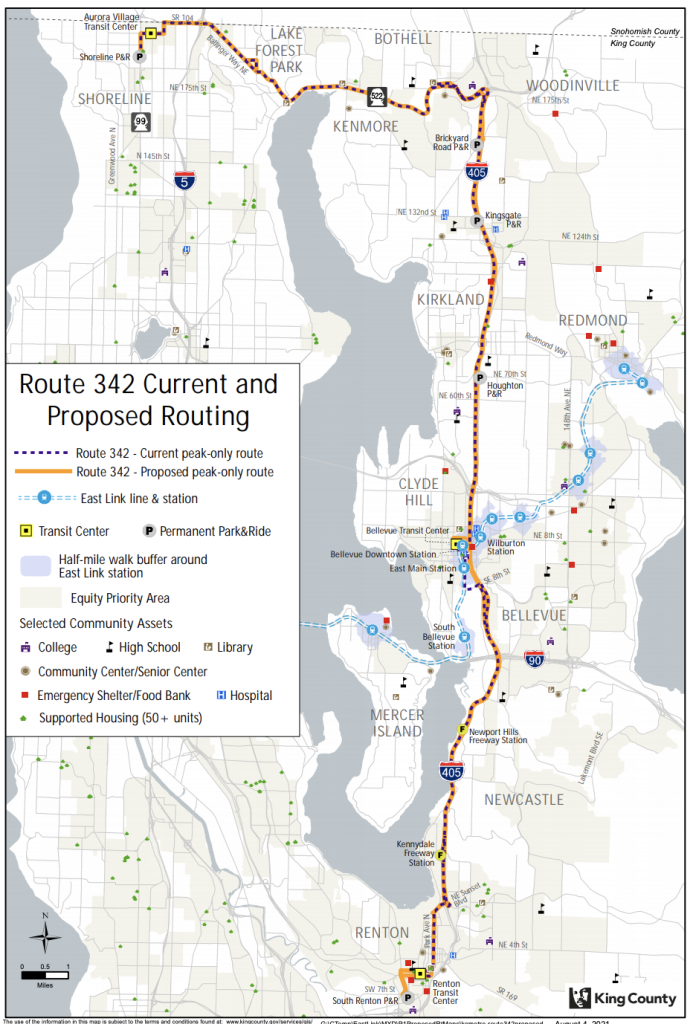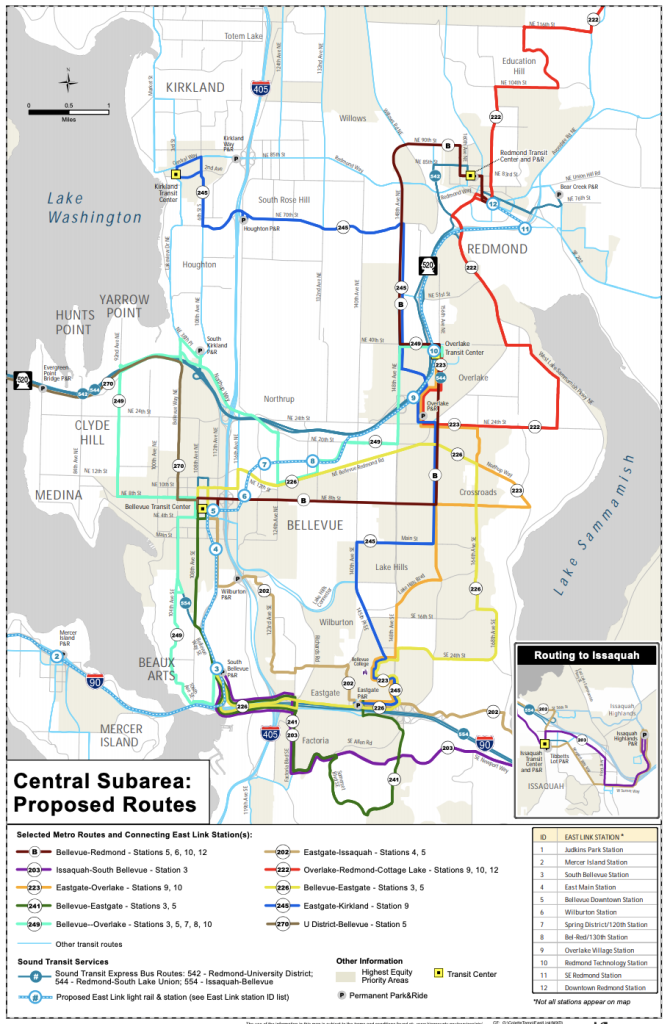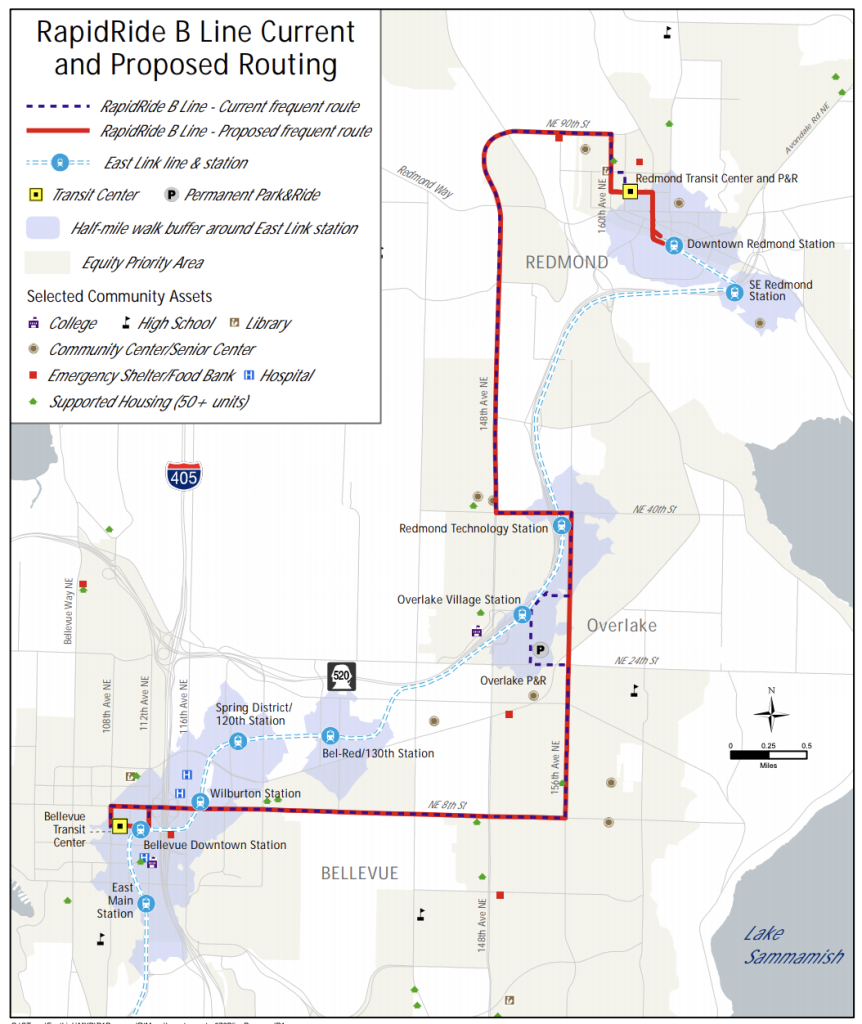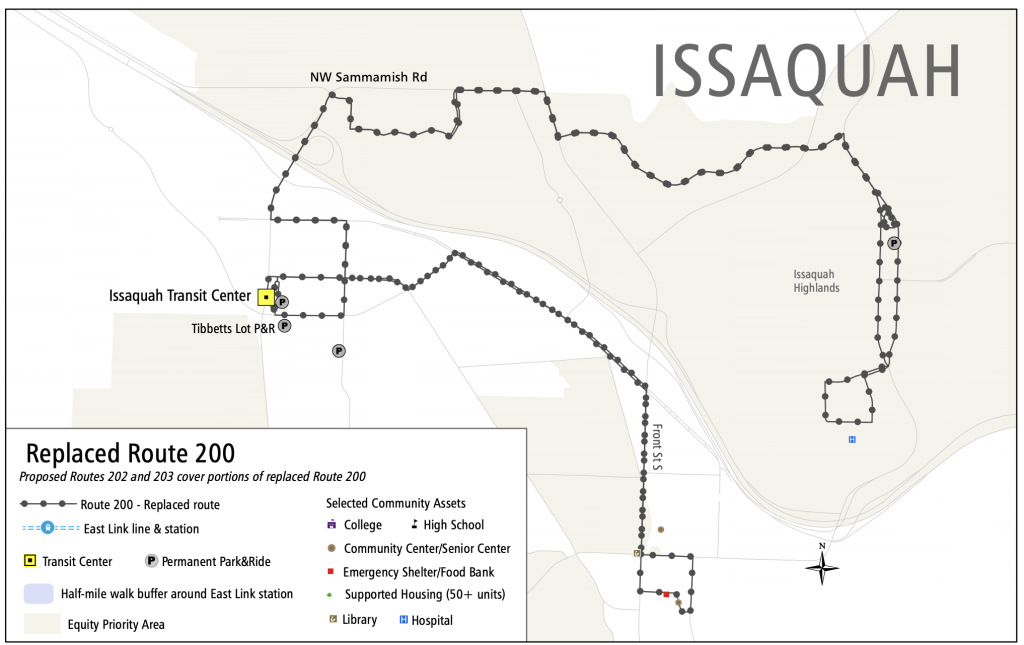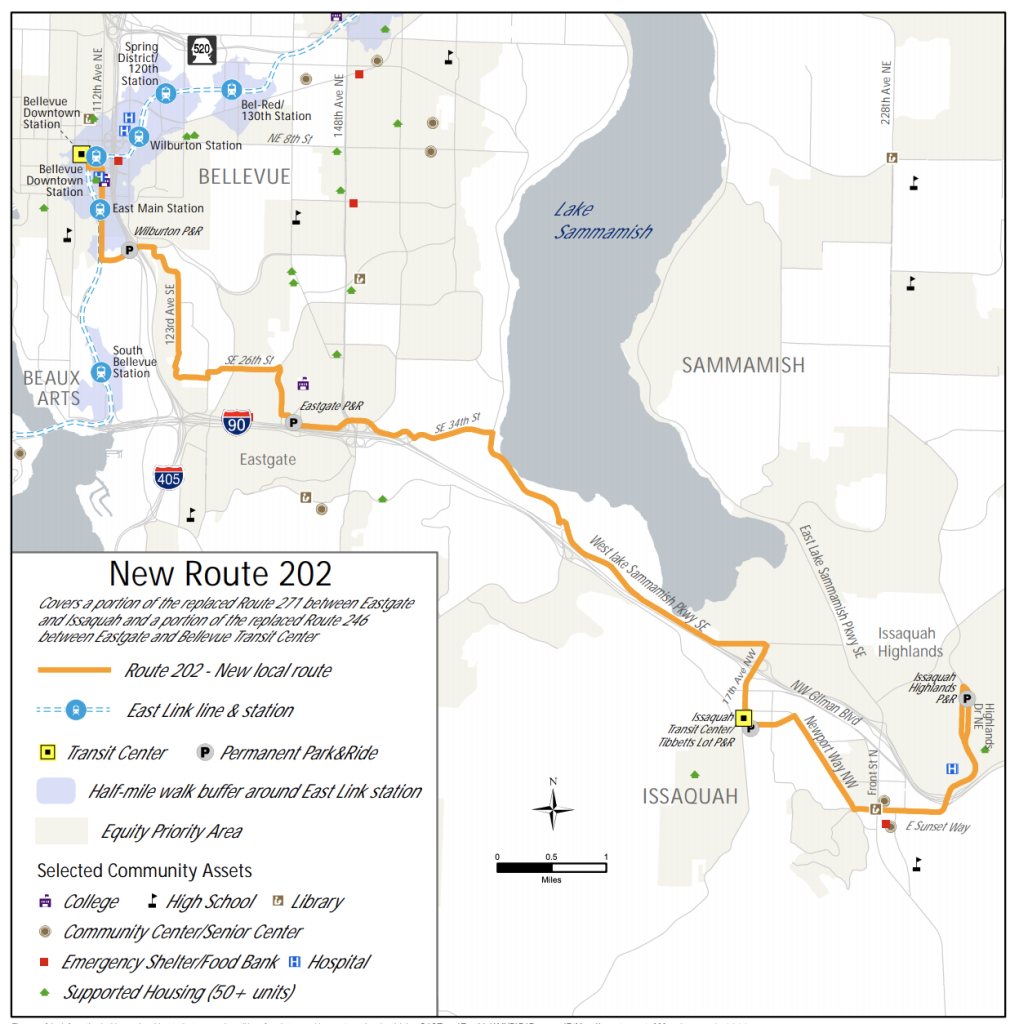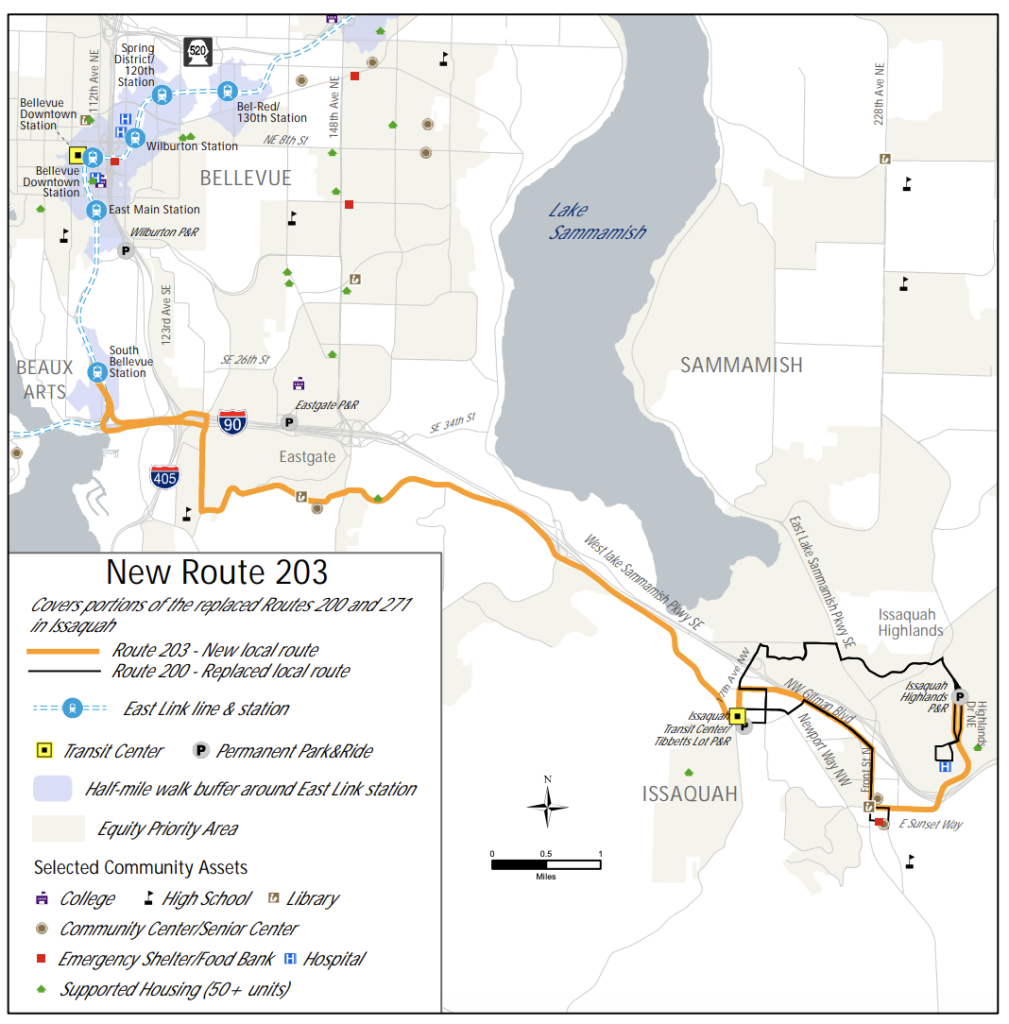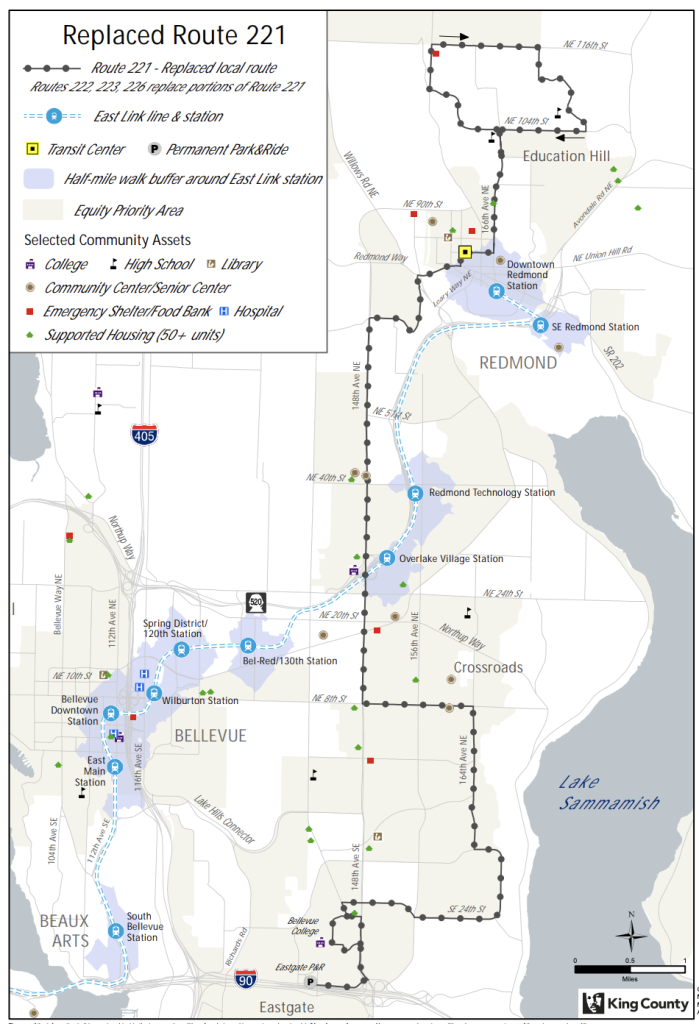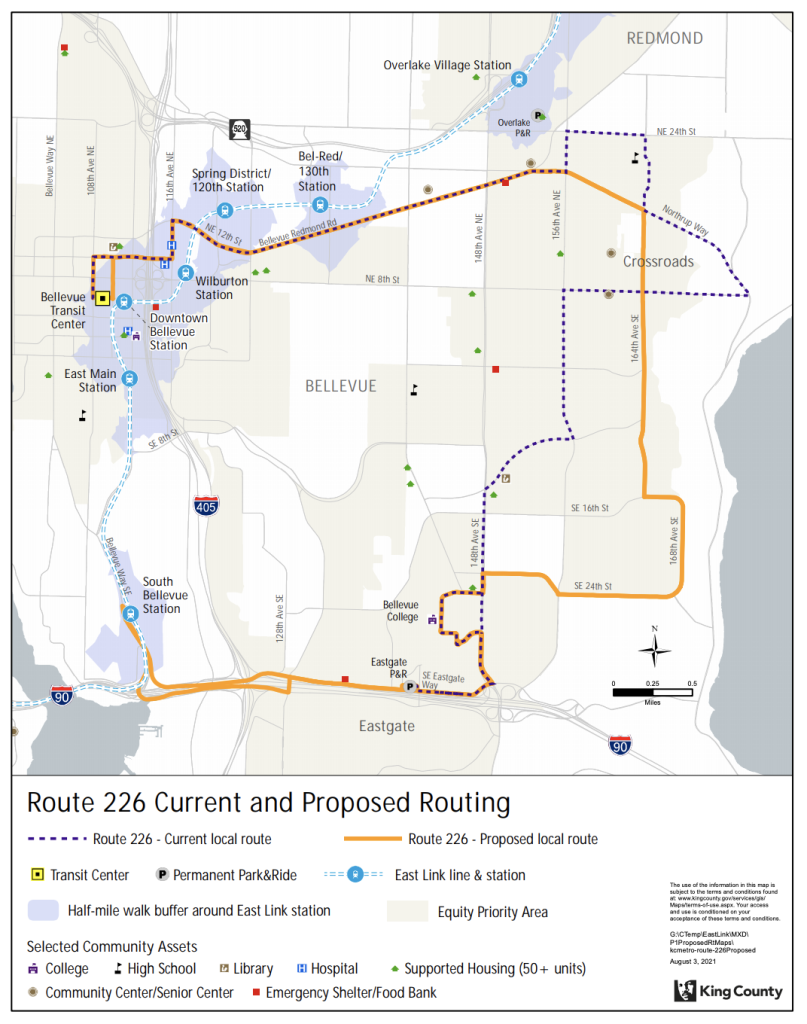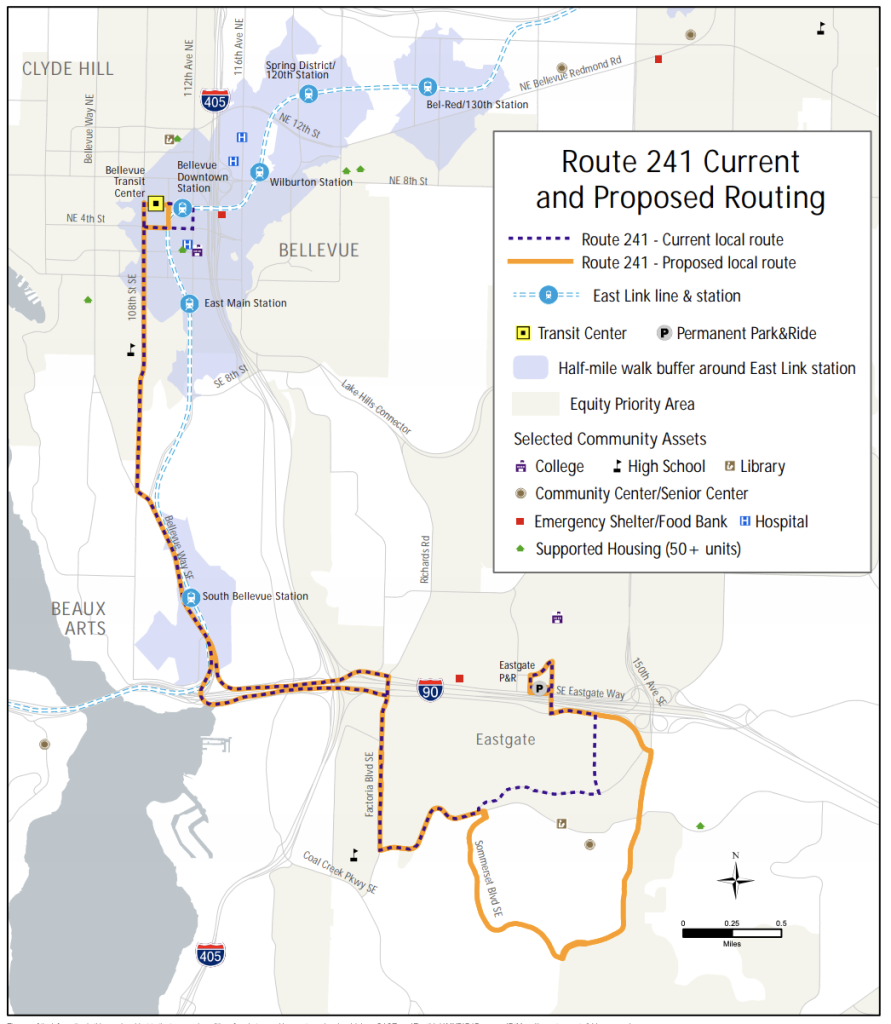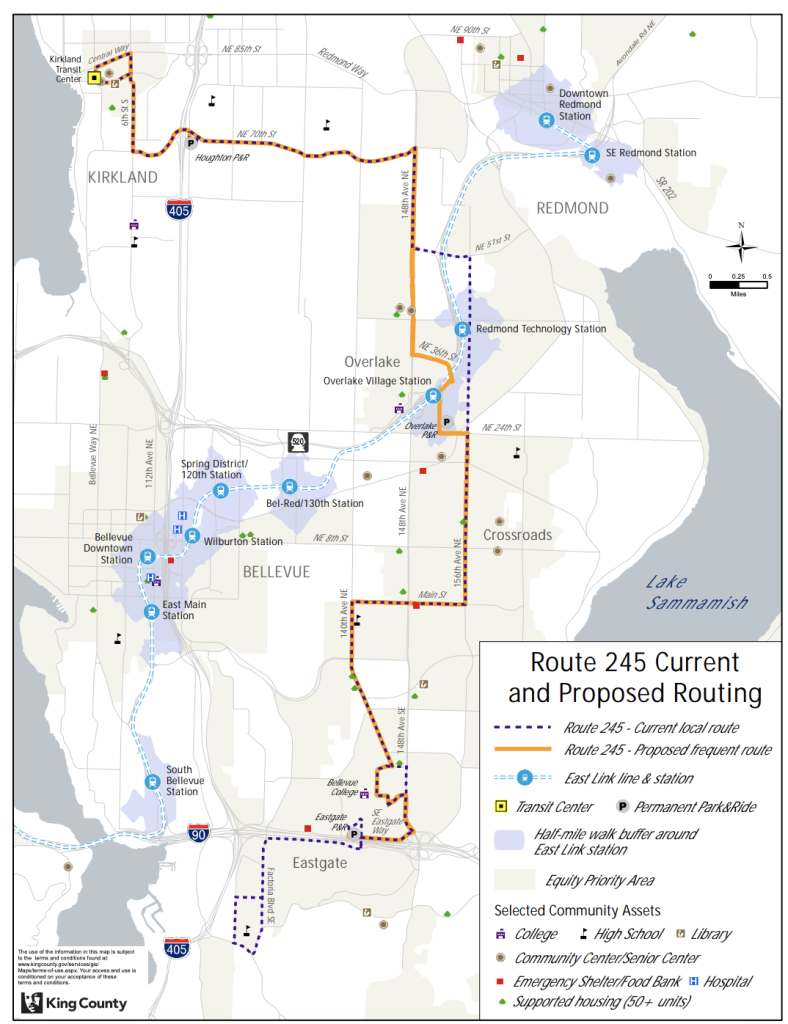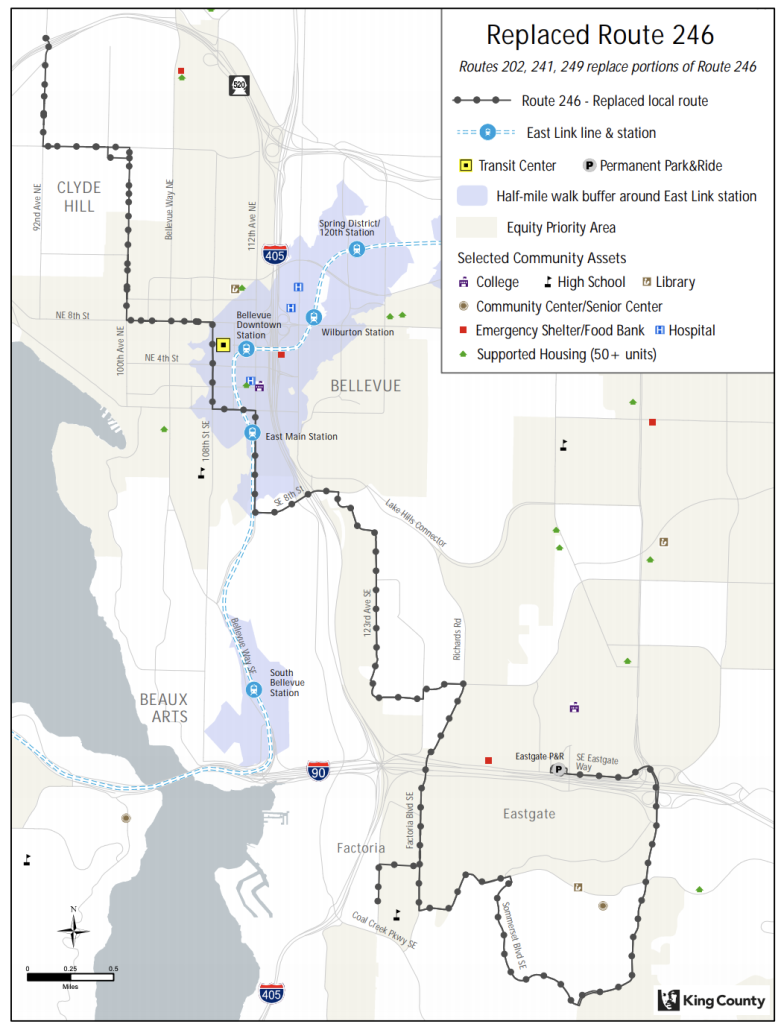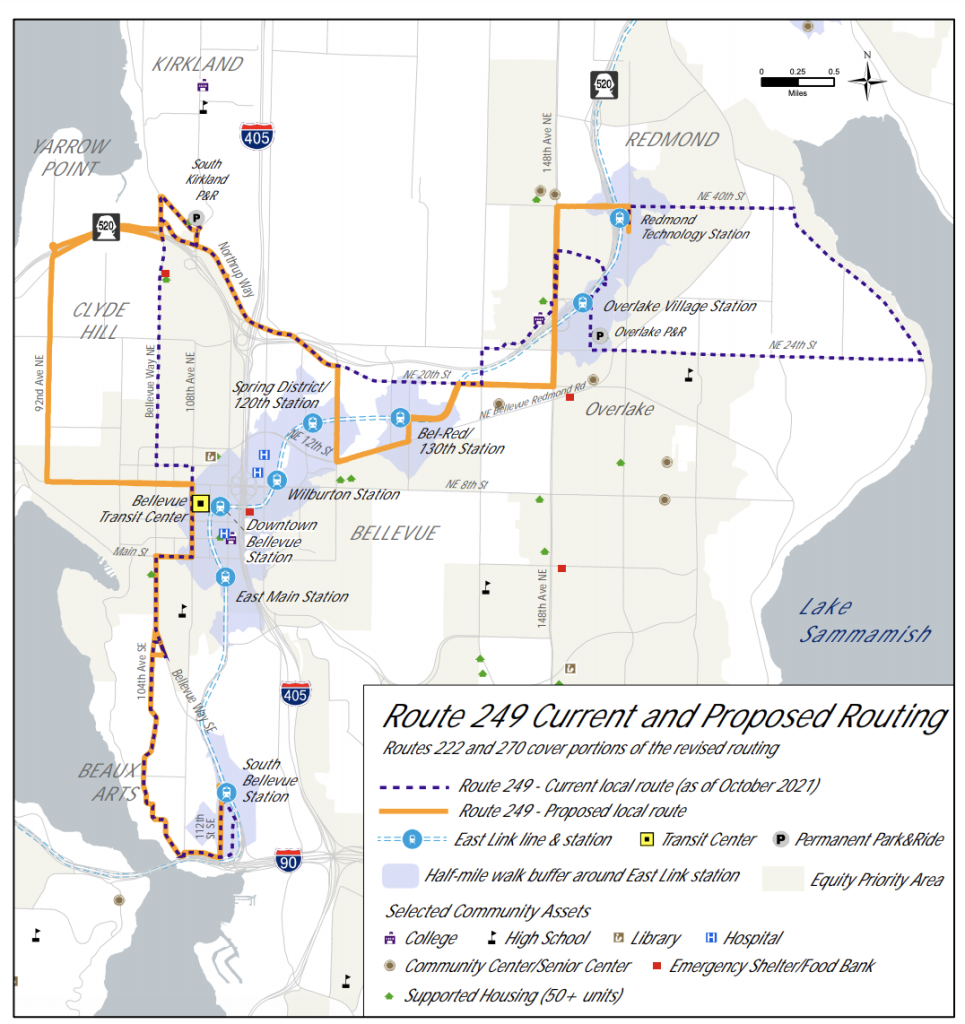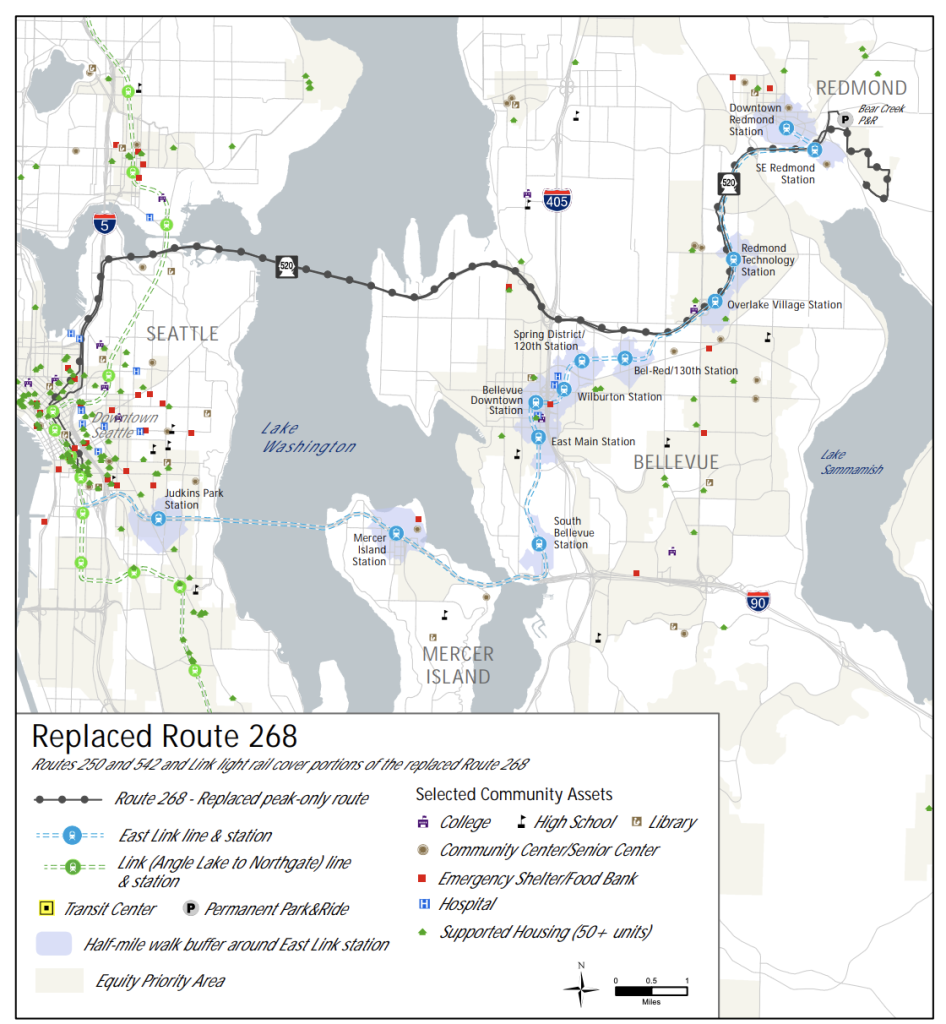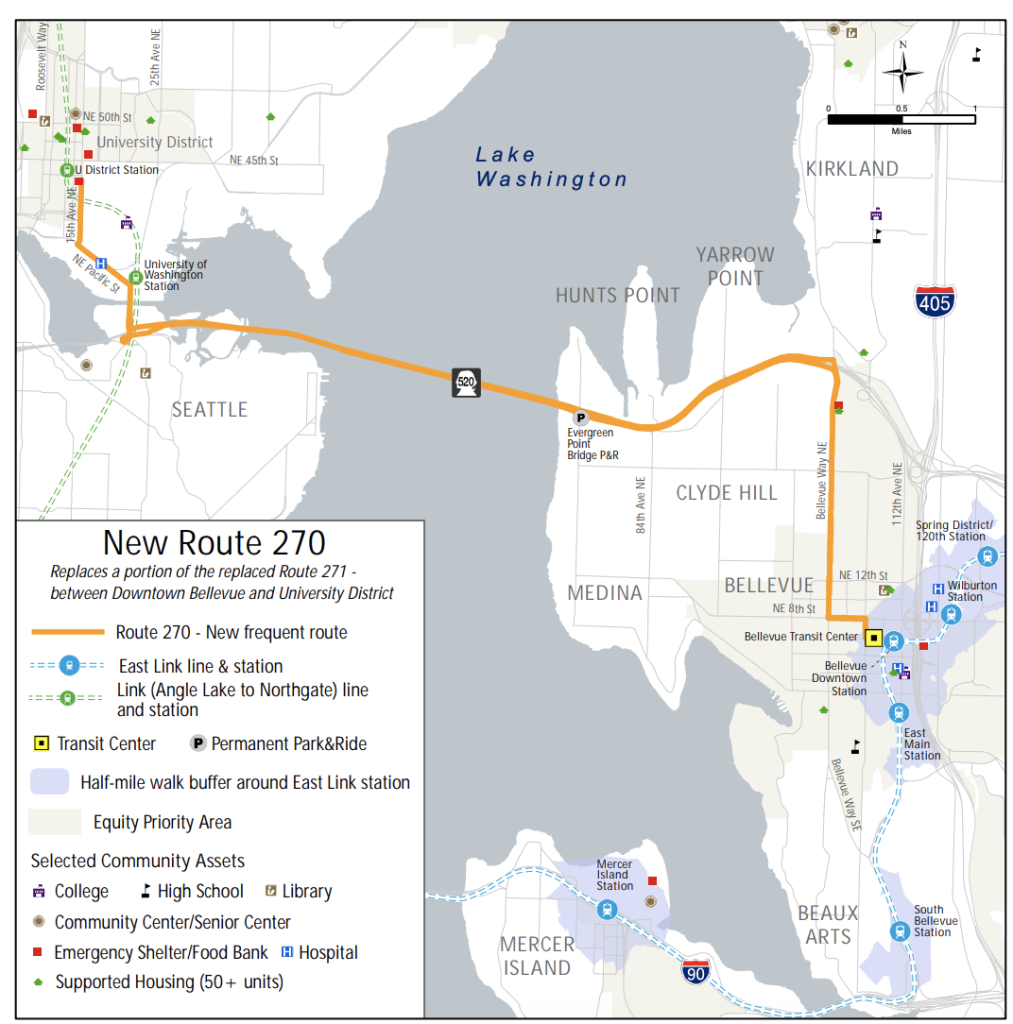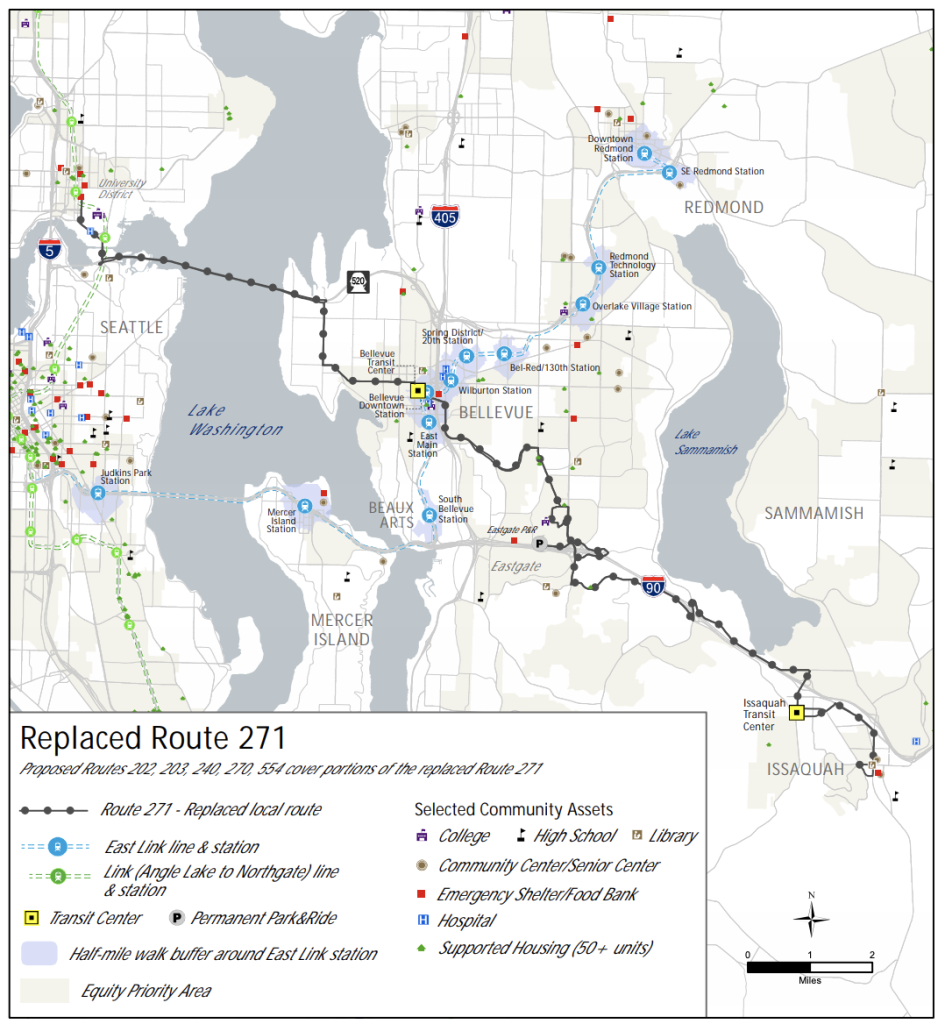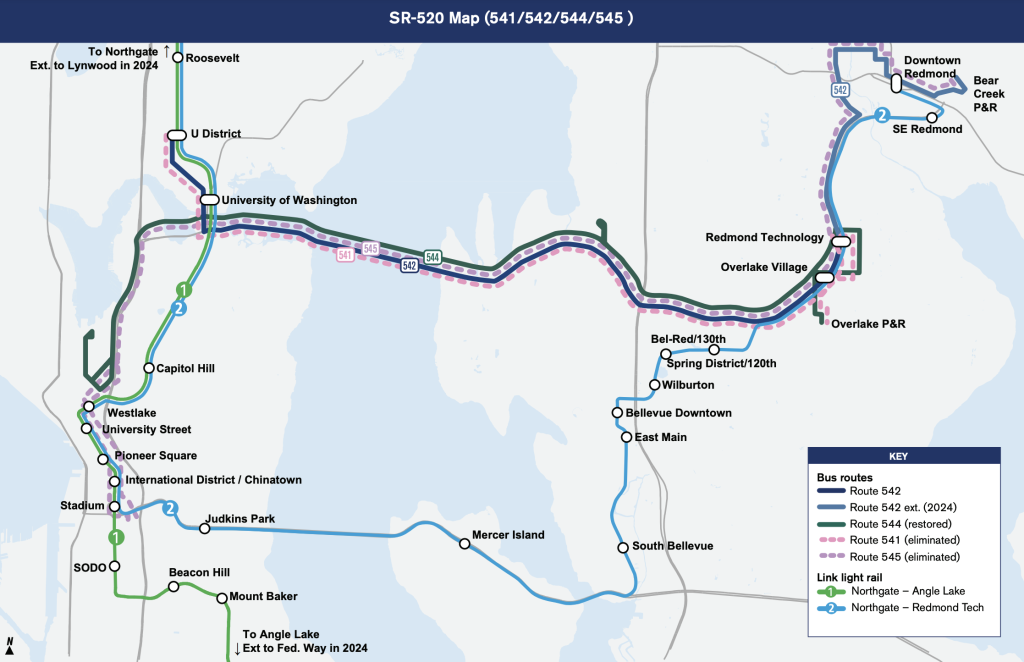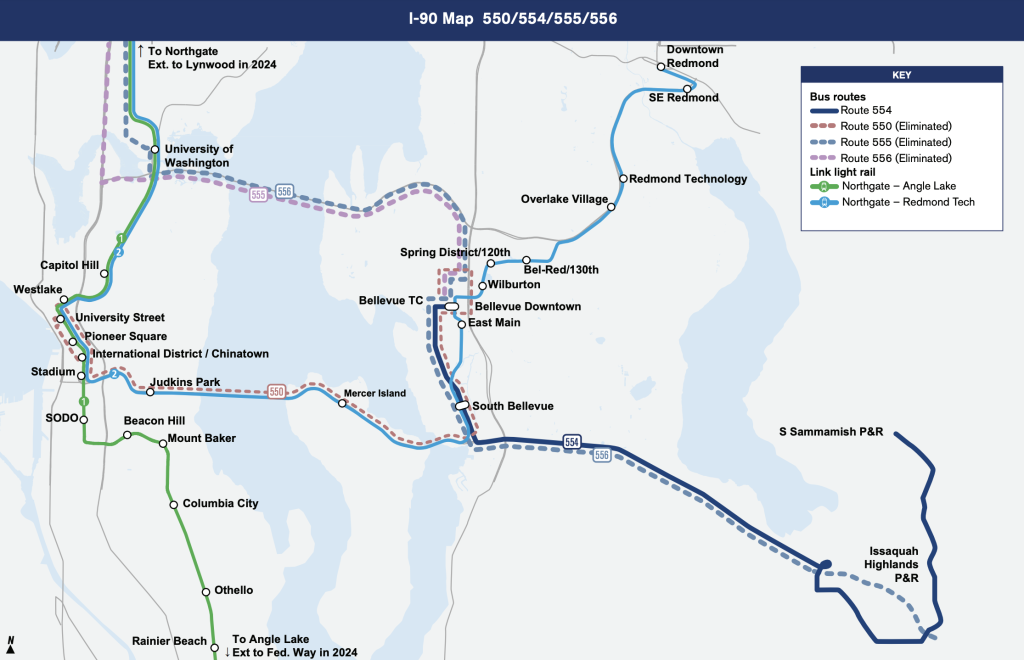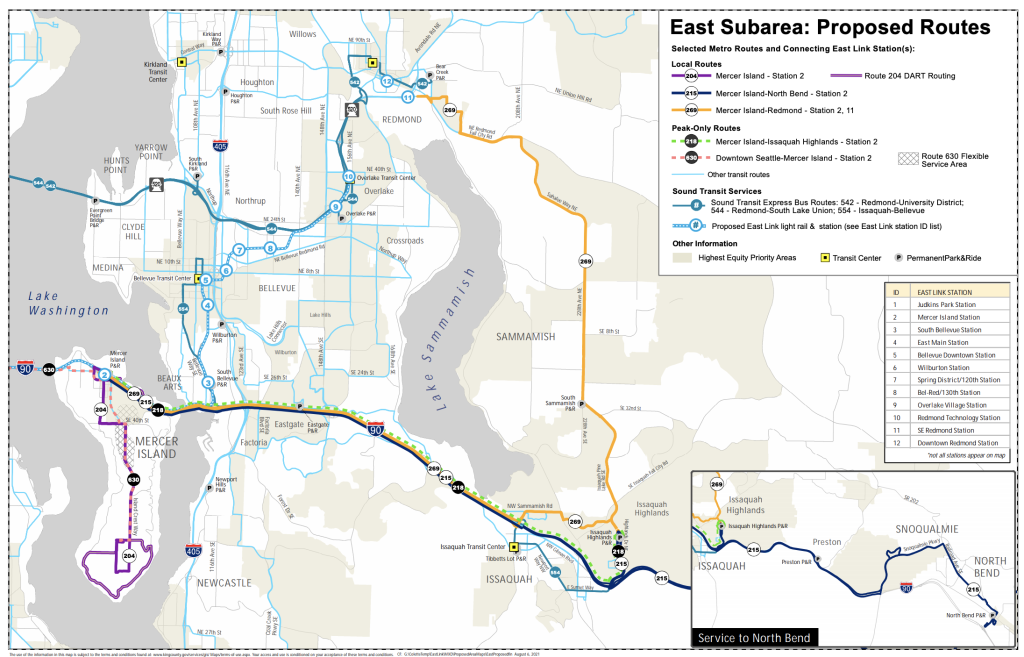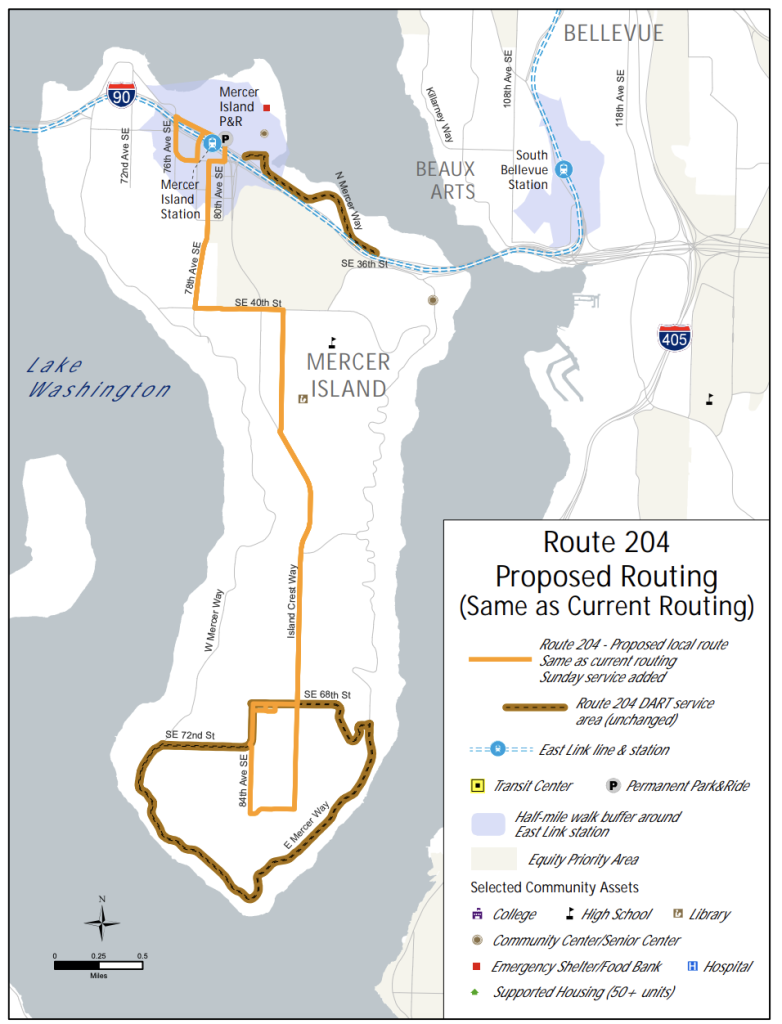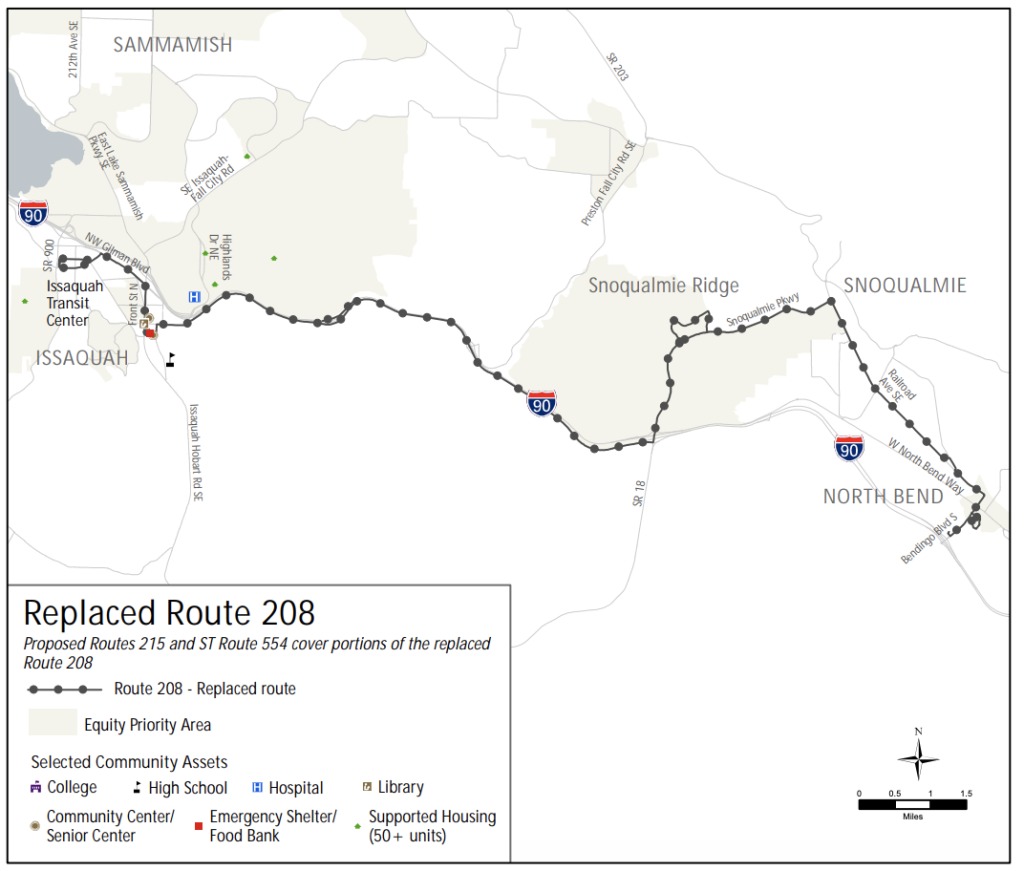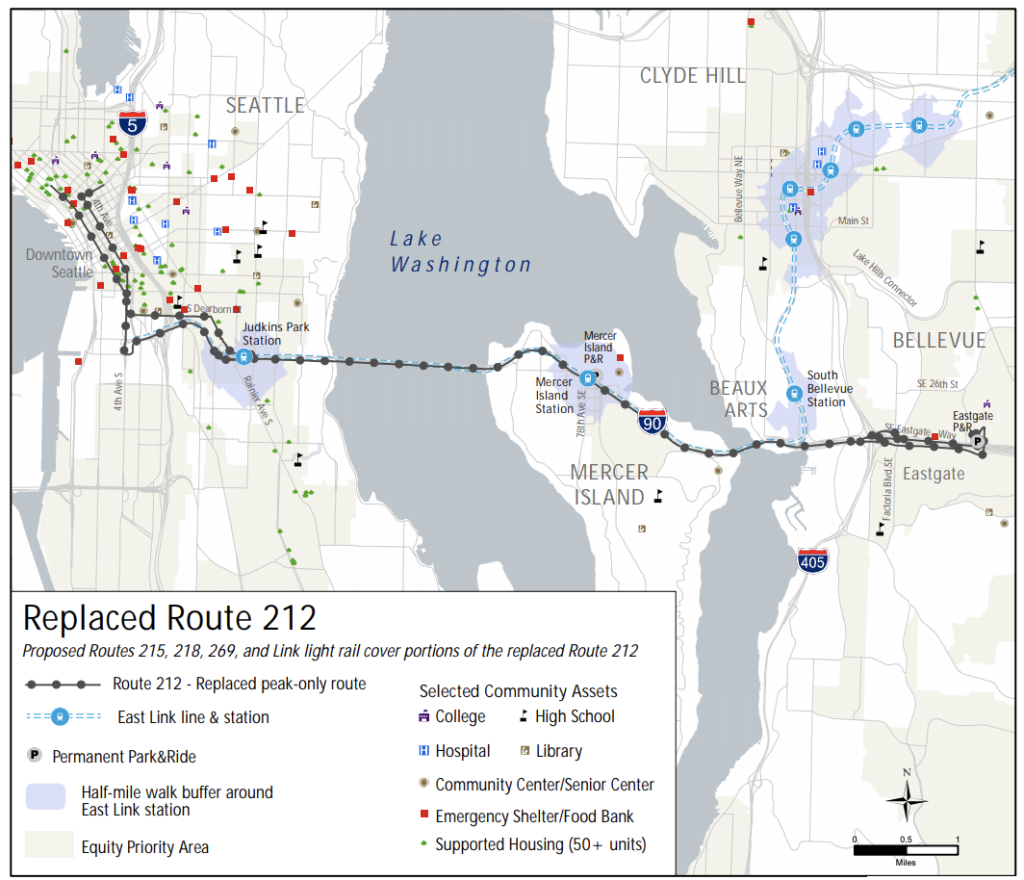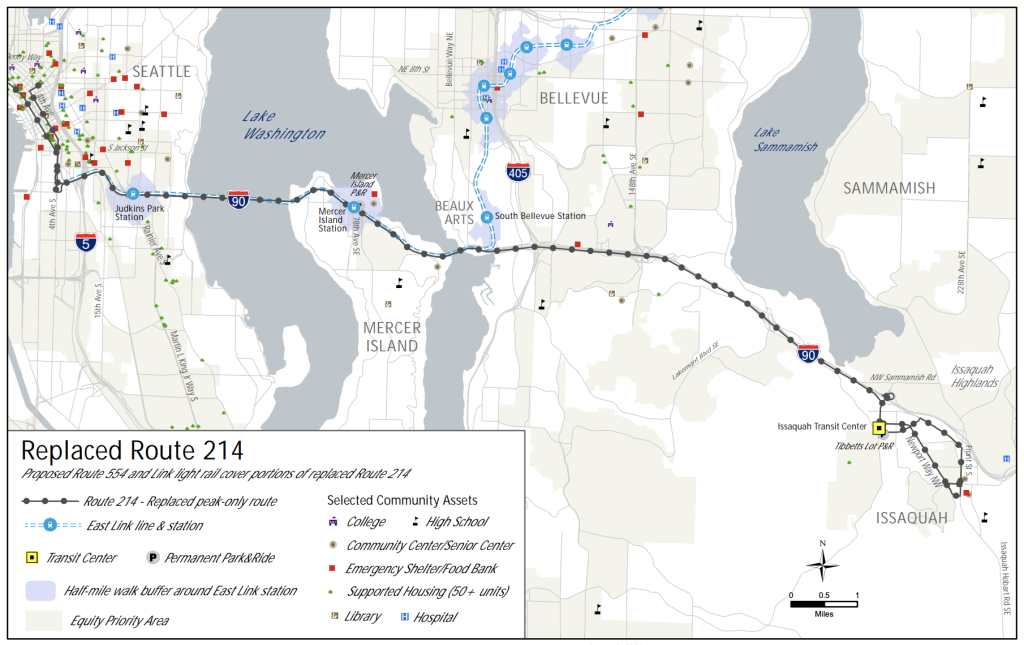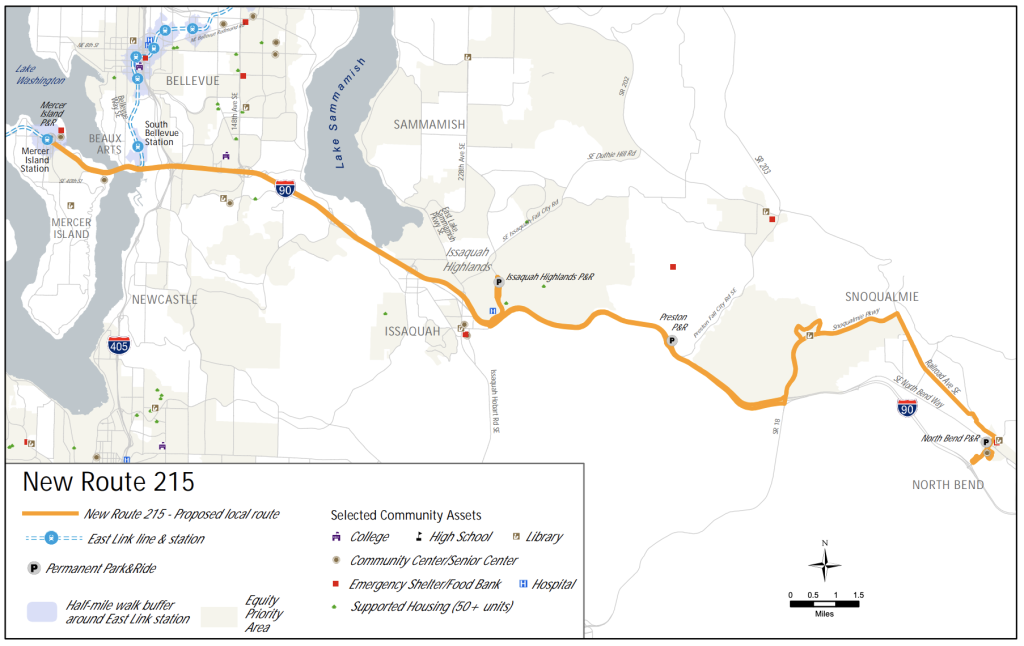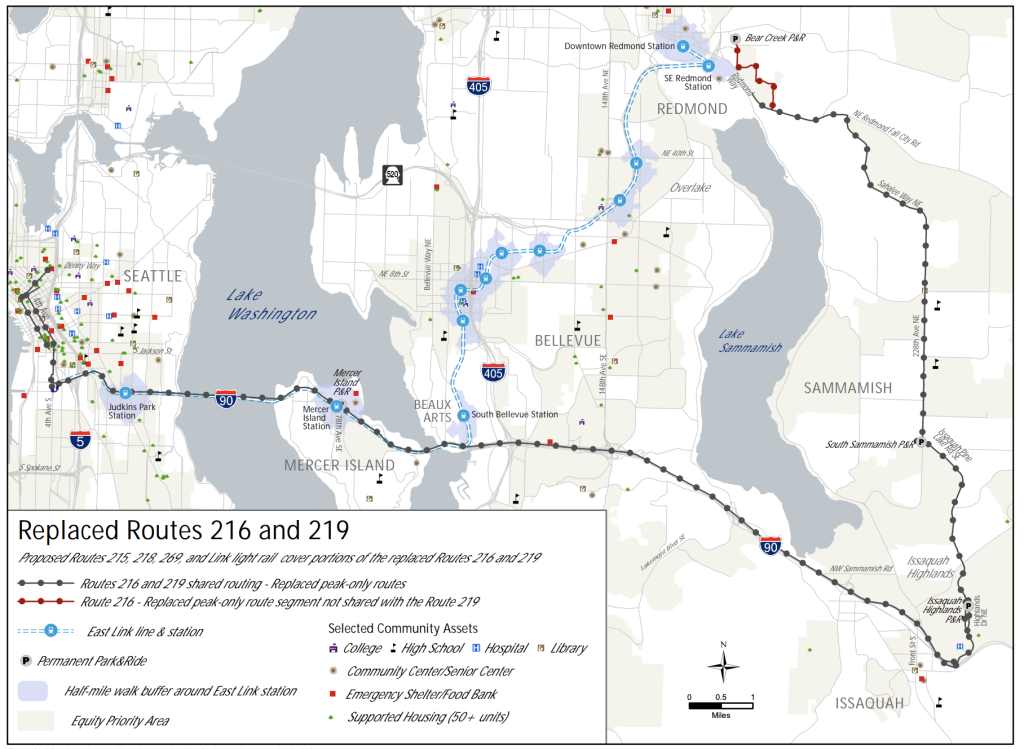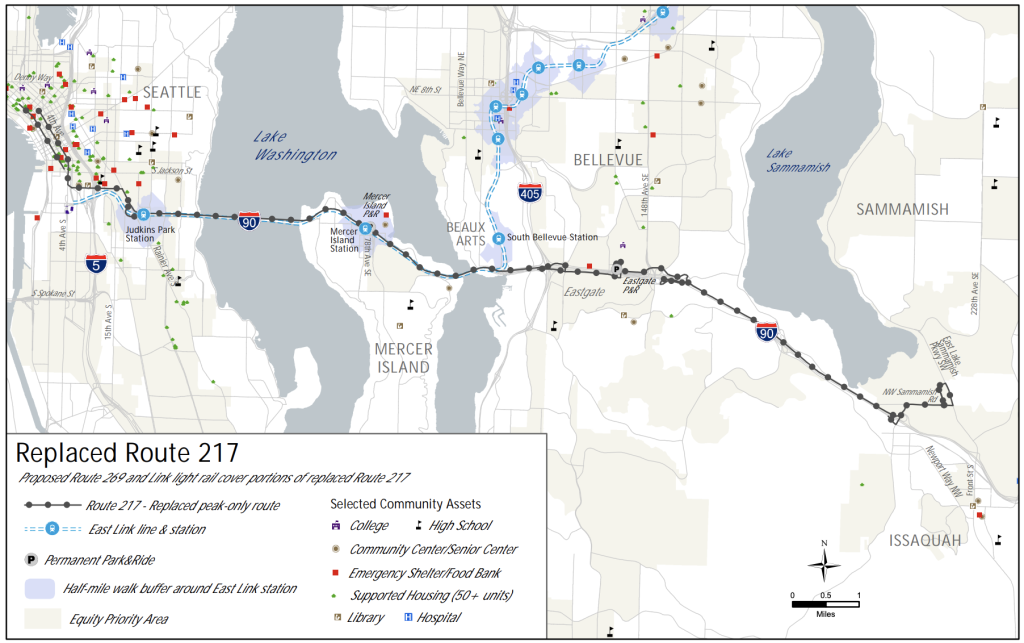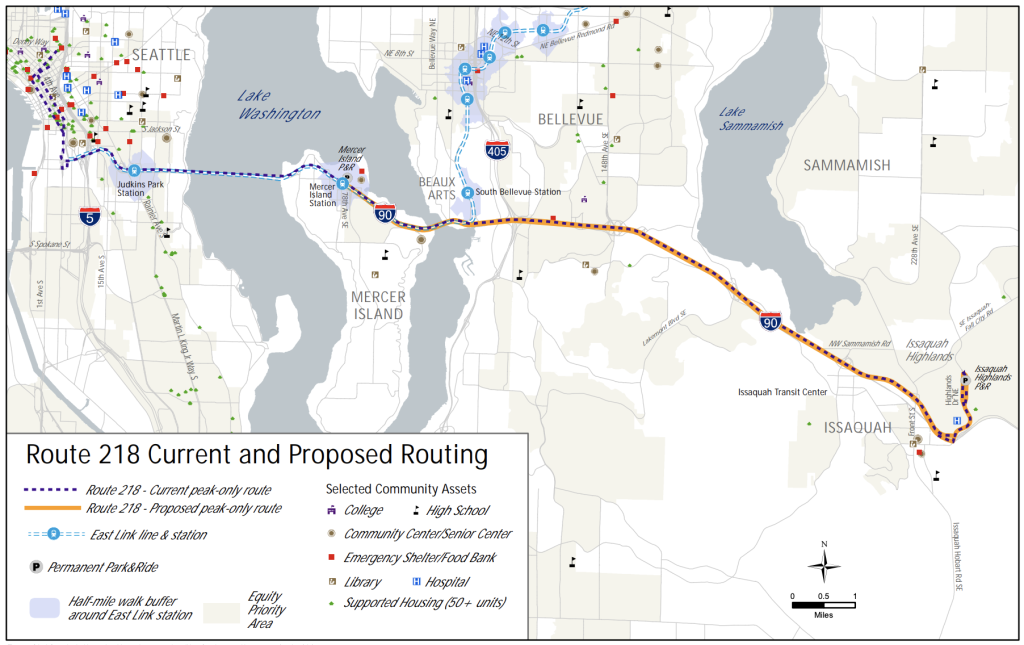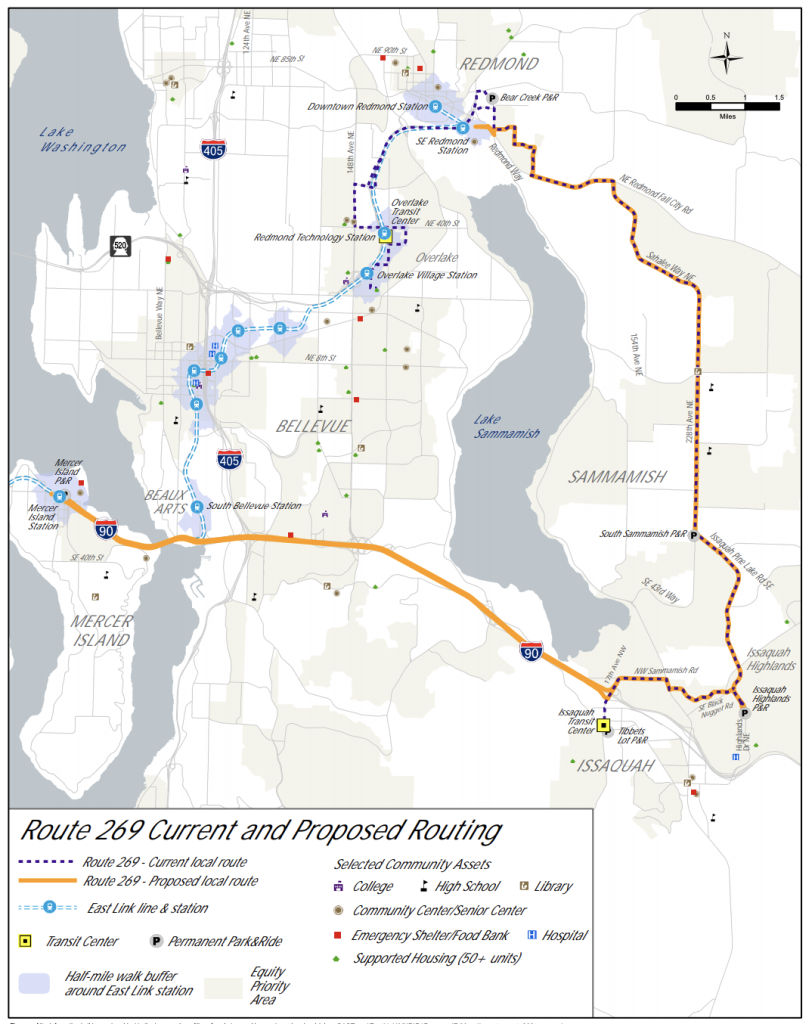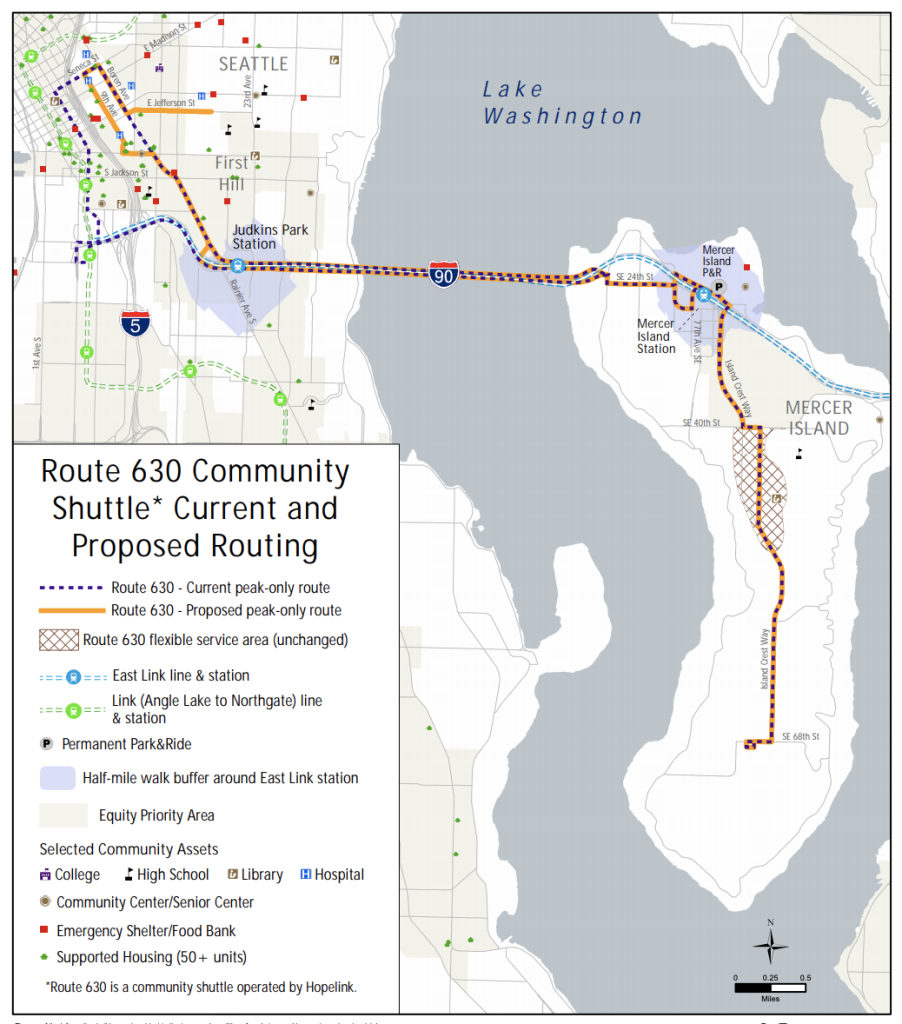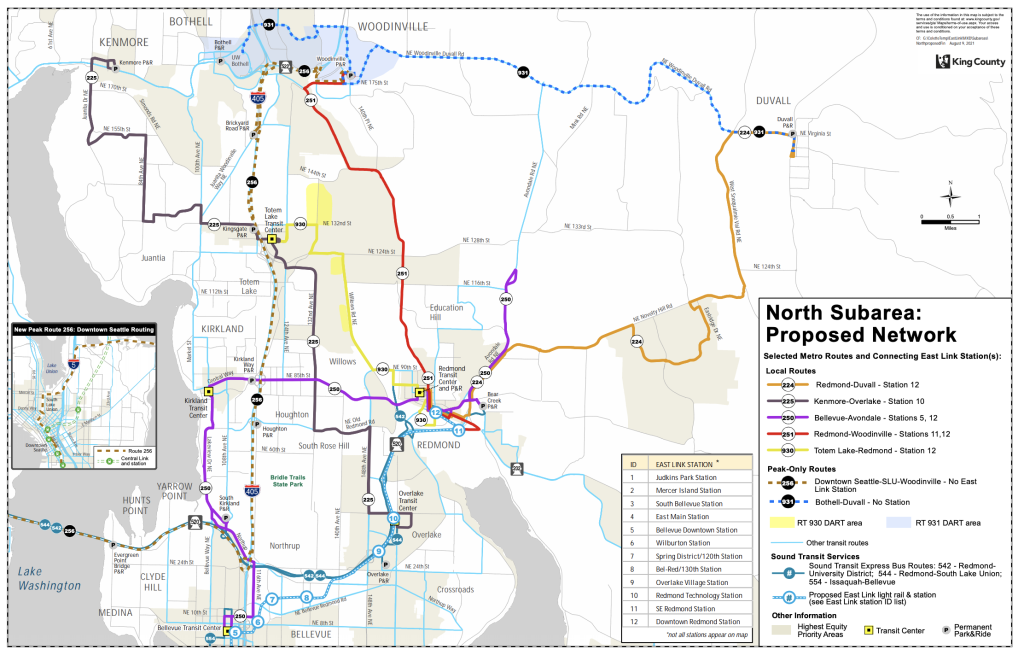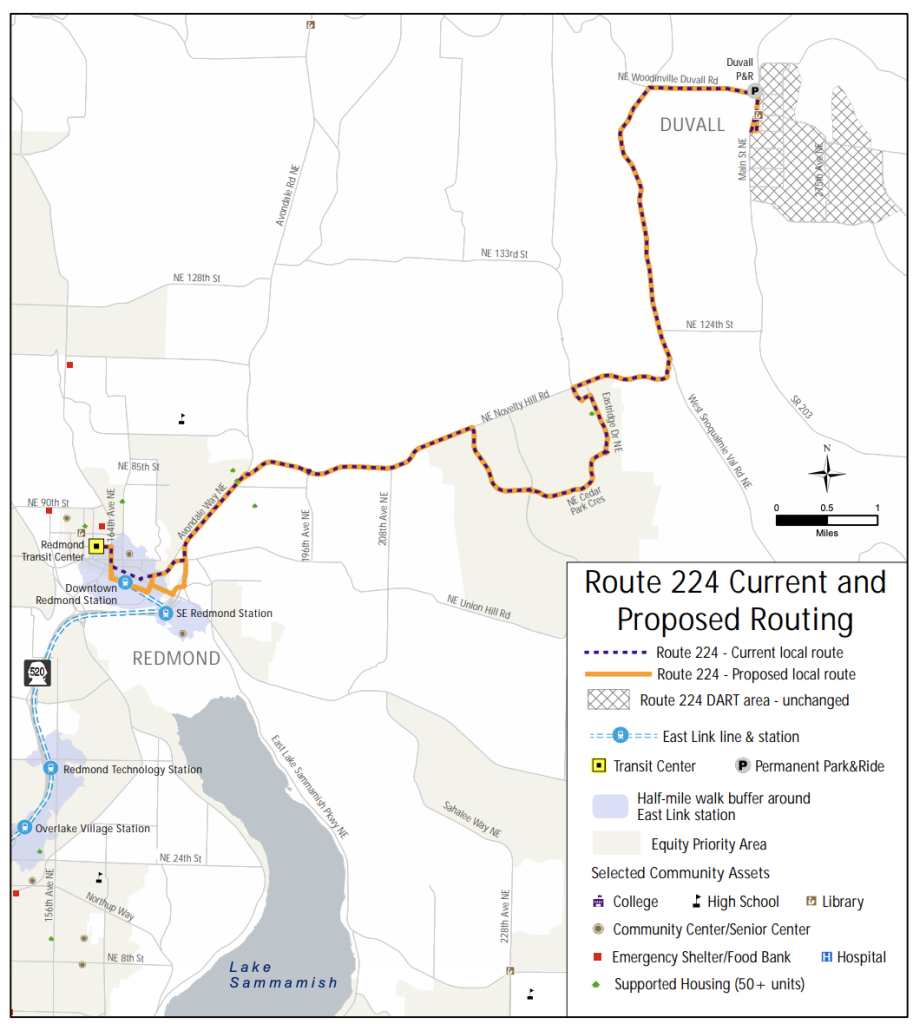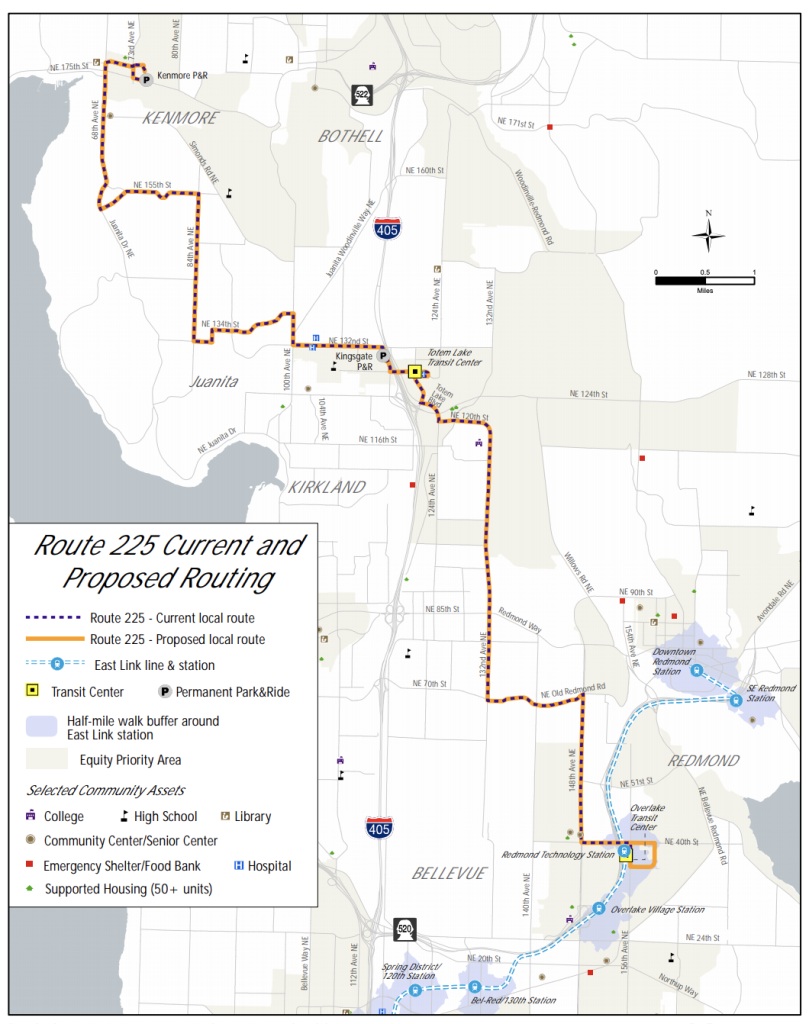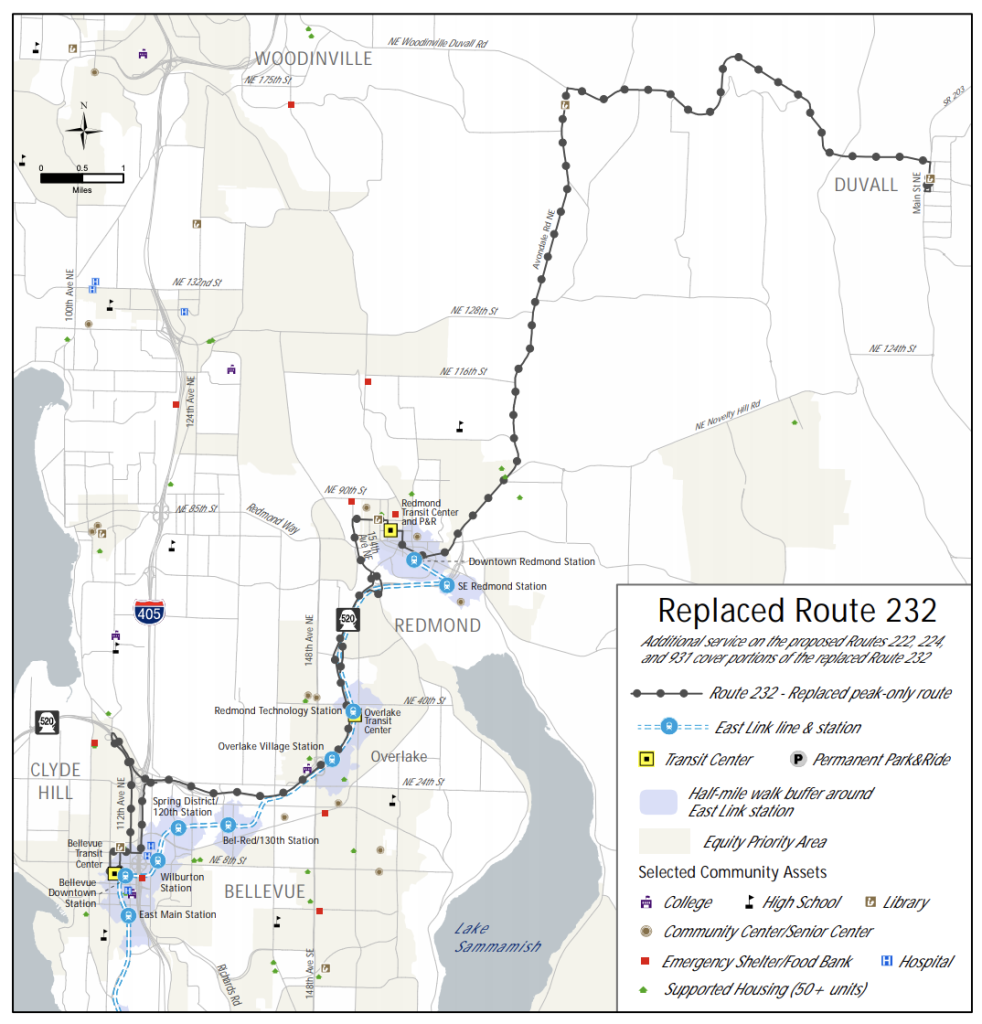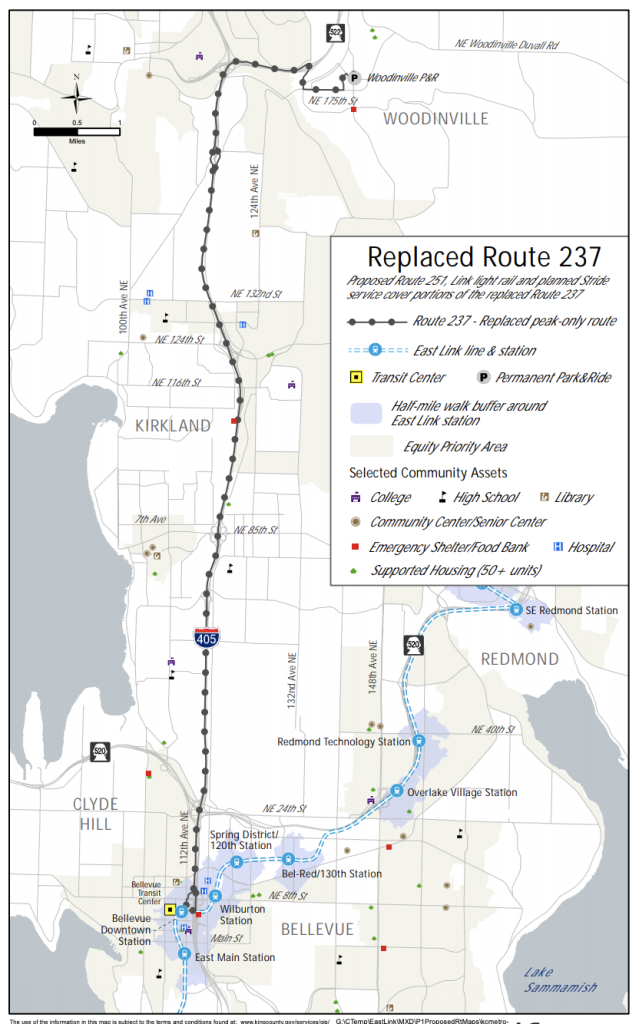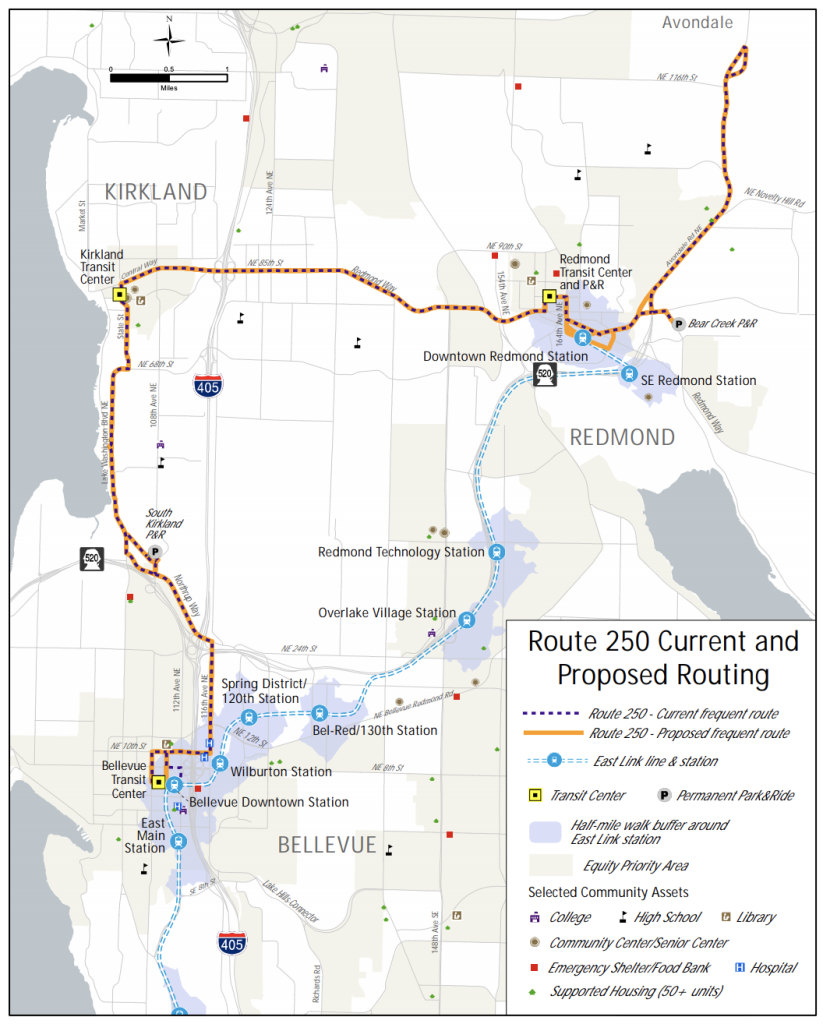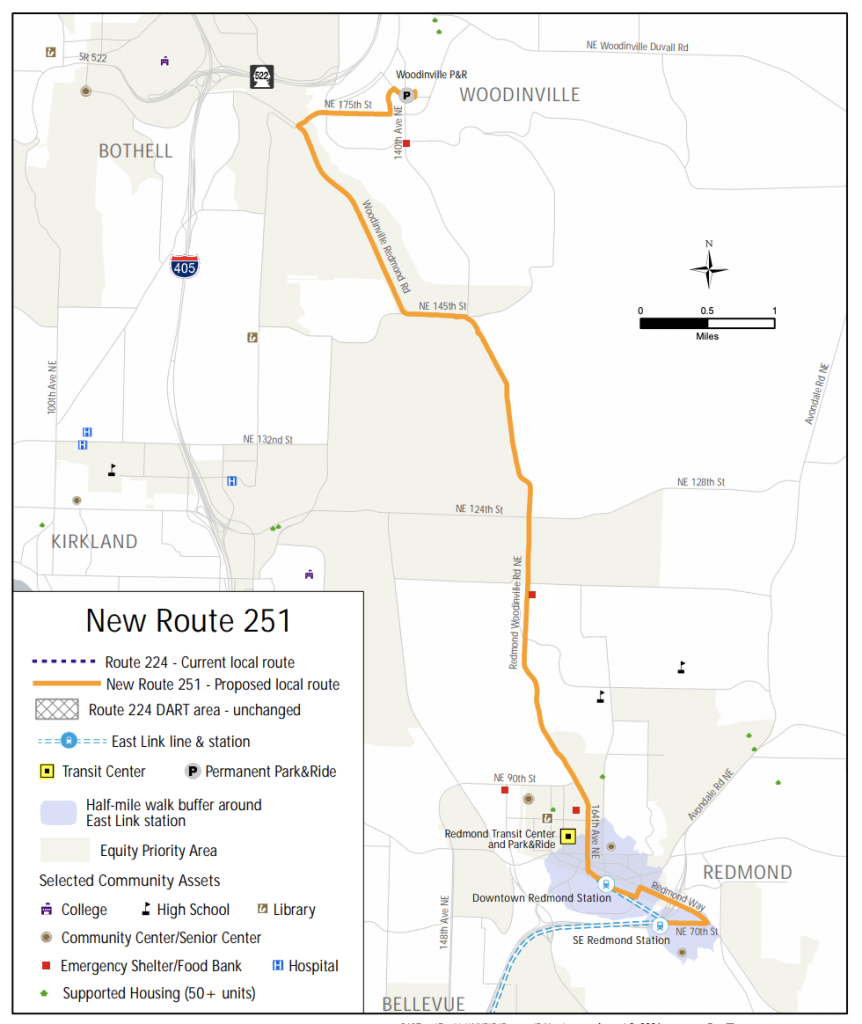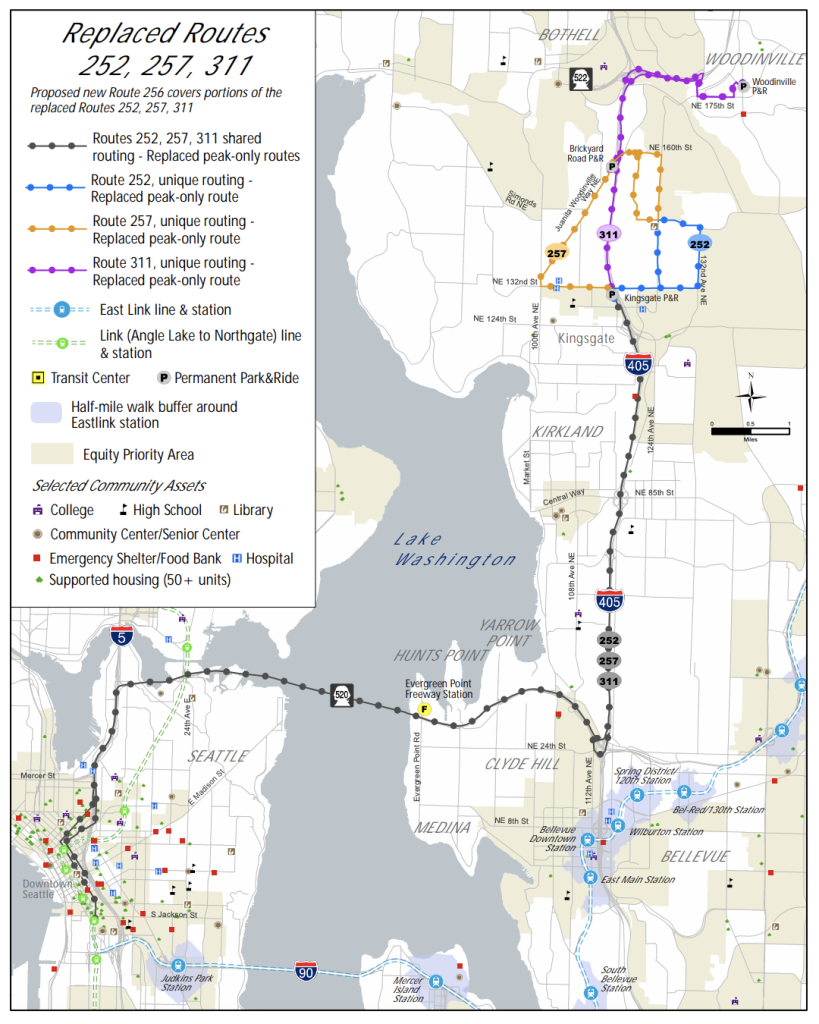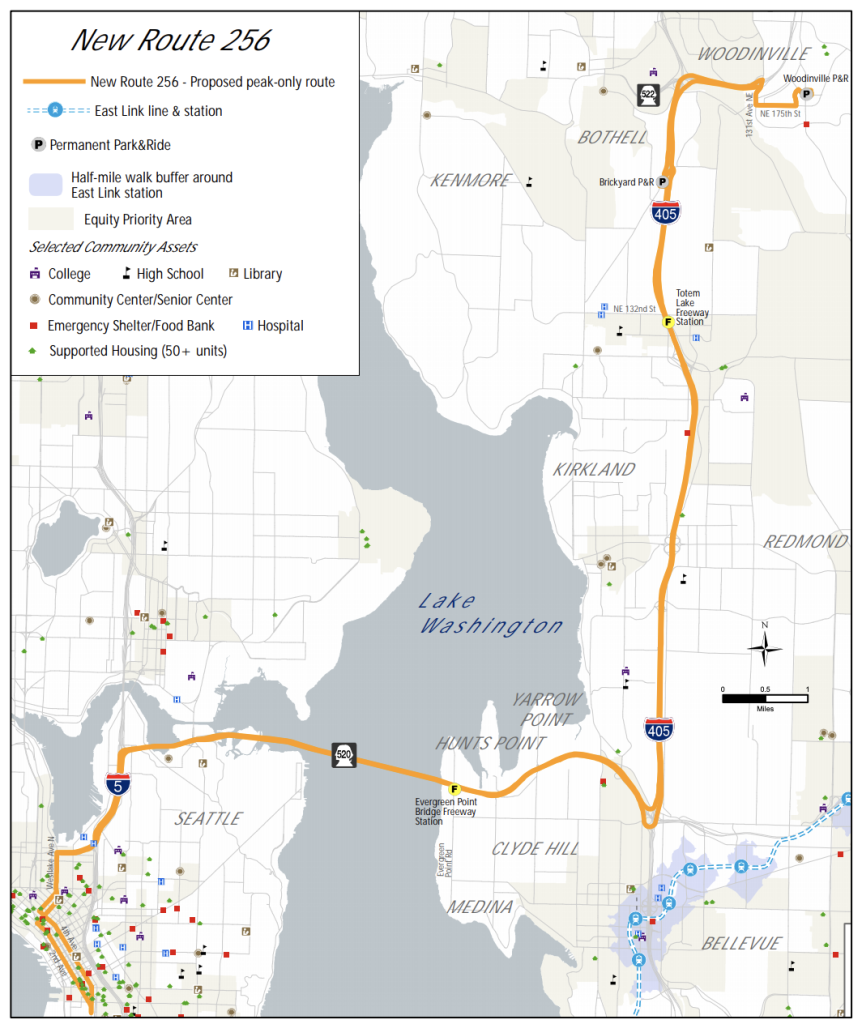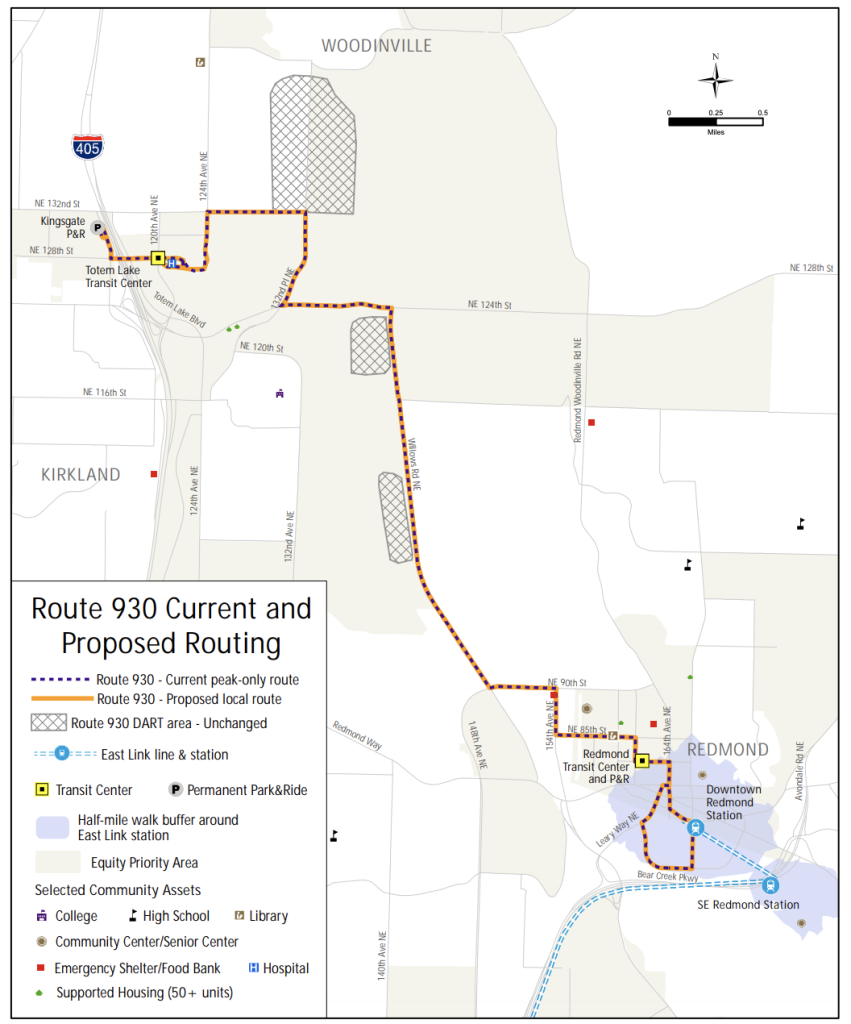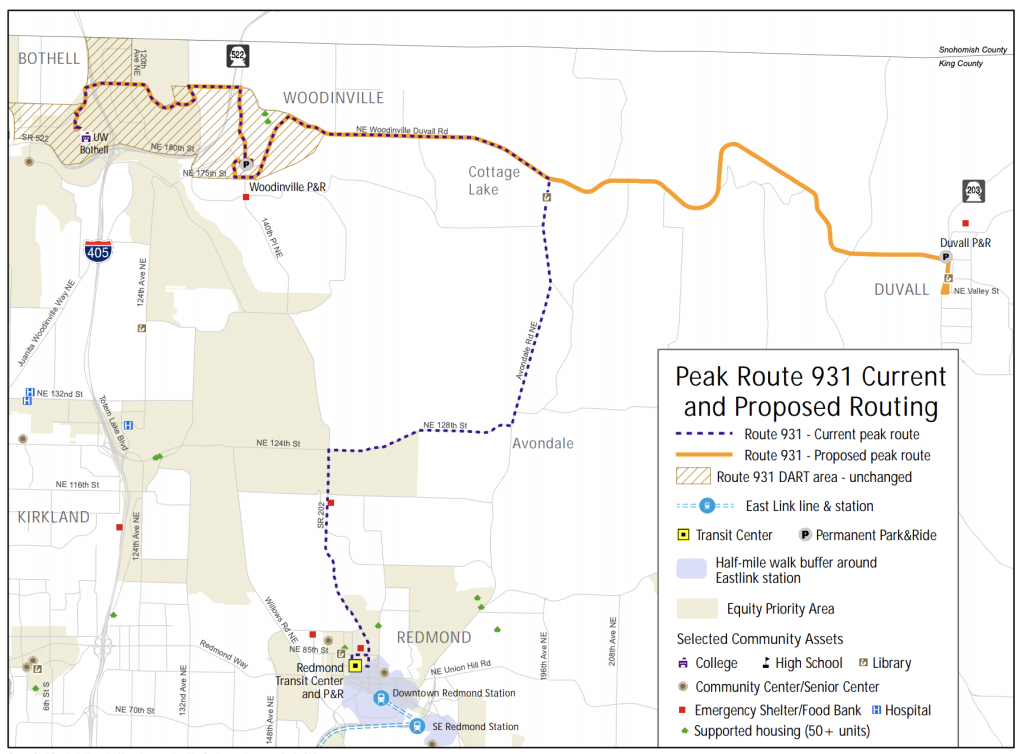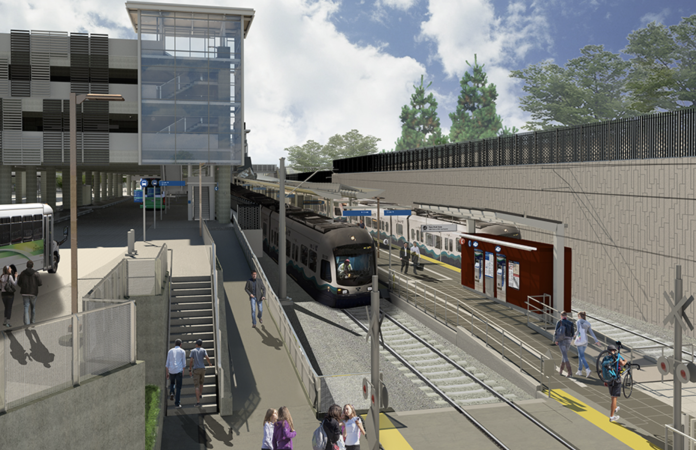
Author’s Note: Some information in this article has been updated based upon new information from King County Metro. Several pieces of information are still subject to change since some route-level information remains incomplete on the online open house.
In 2023, light rail will reach the Eastside with Sound Transit’s newest extension: East Link (to be known as the 2 Line). This is precipitating further bus restructures among King County Metro and Sound Transit bus networks. Service planners are targeting better bus-to-light rail connections while maintaining good local service and achieving equity goals. The bus restructure process is in its second public phase with formal draft proposals, which would affect bus routes throughout the Eastside and could impact routes originating as far away as Seattle, Shoreline, and Renton.
The proposed bus restructure is best thought of as five subareas, which the transit agencies have neatly developed information around. Those include:
- Seattle Subarea (Seattle);
- South Subarea (Renton and Newcastle);
- Central Subarea (Bellevue, Redmond, and Issaquah);
- East Subarea (I-90, Mercer Island, Sammamish, Snoqualmie, and North Bend); and
- North Subarea (Kirkland, Bothell, and Woodinville).
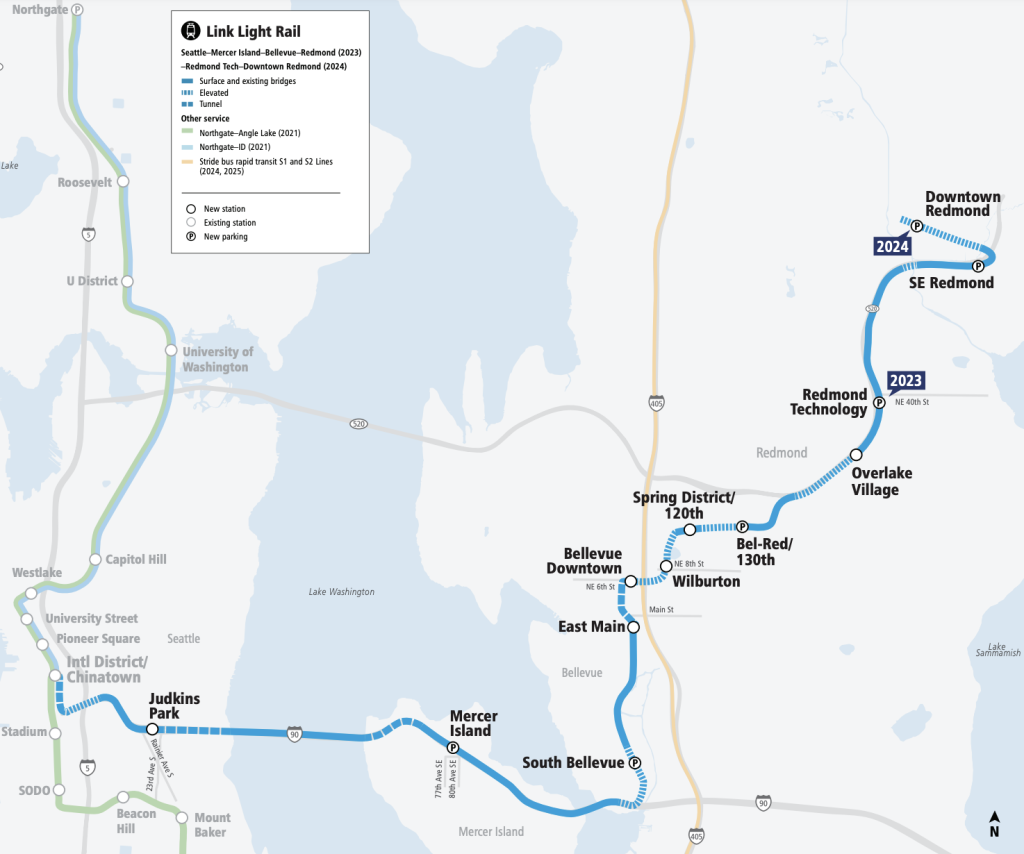
More than 40 bus routes could be affected by the restructure proposals and cover 19 different cities. The 2 Line extension will deliver ten new stations in four cities by 2023 and two additional stations in Redmond in 2024, providing service from Northgate all the way to Downtown Redmond via Capitol Hill and Downtown Seattle. Light rail travel times are estimated to be 18 minutes from Downtown Redmond to Downtown Bellevue, 24 minutes from Downtown Bellevue to Westlake Station in Downtown Seattle, and 50 minutes from South Bellevue to Seattle-Tacoma International Airport.
In developing the proposals, Metro initially sought general feedback earlier this year from the public and directly engaged with a 27-member Mobility Board. Key themes that came out of that process were a desire for more local connections, reasonable transfers, keeping fast travel times, additional weekend and off-peak service, and a focus on primary locations like Downtown Bellevue and Redmond, Microsoft’s campus, colleges, and the Spring District.
Seattle Subarea proposals
The Seattle Subarea only encompasses one principal change and that’s to the southern portion of Route 8. Metro wants to better serve Judkins Park Station by providing another direct connection to the station. Under the existing network, Routes 7, 9, 48, and 106 directly pass by Judkins Park Station, but only Route 48 offers a regular connection for people living in Capitol Hill, Central District, and other Central Seattle areas. Route 8, for its part, operates along Martin Luther King Jr. Way, which is at least four blocks away from Judkins Park Station.
To provide a better connection, Metro is proposing that Route 8 be revised to fully serve 23rd Avenue S south of S Jackson Street. This would allow the route to pick up Judkins Park Station on its way to Mt. Baker Station and Mt. Baker Transit Center. The route would also run on Rainier Avenue S between the two light rail stations. However, this would mean that some stretches of Martin Luther King Jr. Way would lose frequent bus service north and south of I-90. Route 4 partially compensates for this, but it doesn’t fully solve the problem.
Metro could choose to revise Route 8 off of Martin Luther King Jr. Way further south than currently proposed and still send buses to 23rd Avenue S to pick up Judkins Park Station and then weave back to Martin Luther King Jr. Way, but that would mean using less developed streets, possible removal of street calming features, and slowing buses down with turns. That could be slightly ameliorated by removing the E Yesler Way jog though.
South Subarea proposals
The big ideas for the South Subarea proposal are a strong connection to the future South Bellevue Station and bidirectional Route 342 from Renton to Shoreline. The proposal involves changes to five routes, including the elimination of peak-only Routes 114 and 167. The latter two routes would essentially be consolidated to a shortened Route 111 with improved span of service. As for Routes 240 and 342, these routes would see alignment revisions mostly in Bellevue with some minor changes in Renton.
| Routes | Proposed Changes |
| 111 | Route 111 plus light rail essentially will replace and consolidate Routes 114 and 167, but doing so with a two-seat ride. This has a big benefit though because Route 111 would become an all-day, seven-day route with half-hourly frequencies. The alignment of Route 111 would be trimmed back to the future South Bellevue Station, which is where riders would transfer to and from light rail to reach Bellevue or Seattle. A few minor adjustments to route in the Renton Highlands are also proposed, which cut back the loop near Lake Kathleen and small zags elsewhere. |
| 114 | This route would be eliminated. |
| 167 | This route would be eliminated. |
| 240 | This route would mostly be adjusted in Bellevue by pulling it onto SE 36th Street, 150th Avenue SE/145th Place SE to serve Bellevue College, the entirety of the Lake Hills Connector, and 116th Avenue NE to reach the downtown transit center and light rail station. This would mean the route no longer runs along 112th Avenue NE since a light rail station will open there and Route 202 would pick up the segment. In Renton, a small segment that leaves NE Sunset Boulevard for NE 12th Street would be pulled back to NE Sunset Boulevard. |
| 342 | Route 342 would see a few minor change to its alignment through Bellevue. Instead of running along SE 8th Street and 112th Avenue NE south of Downtown Bellevue and its transit center, the route would be adjusted to exclusively use the direct access ramps from I-405 to reach the transit center and new Downtown Bellevue light rail station. The route would then continue as normal to Shoreline and Renton. In Renton, the route would also be further extended southward to the South Renton Park-and-Ride. Additionally, the route would operate in both directions during peak hours, frequency would be 30 to 45 minutes instead of 25 to 45 minutes during peak hours, and span of service would slightly expand. |
Central Subarea proposals
The big ideas for the Central Subarea are: connections to the many light rail stations Bellevue and Redmond are getting; wider Central, South, and East Bellevue coverage; and better connections to and service in Issaquah. This proposal involves creation of several new bus routes and consolidation of many others. Strong poles for service would be Bellevue College, Eastgate Park-and-Ride, Crossroads, and the future South Bellevue, Downtown Bellevue, Overlake Village, and Redmond Technology Stations.
| Routes | Proposed Changes |
| B Line | This route would be slightly adjusted to straighten out the route in Overlake and extend the tail from the Redmond Transit Center to Downtown Redmond Station. |
| 200 | This route would be eliminated. |
| 202 | This would be a new route running between Downtown Bellevue and Issaquah. It would cover area served by Route 240 in Central Bellevue by running on 112th Avenue NE, SE 8th Street, 132nd Avenue SE, SE 26th Street, 139th Avenue SE, and SE Eastgate Way. This adds service to some areas without comparable coverage today. From Eastgate, service would run on SE Eastgate Way, SE 34th Street, and West Lake Sammamish Parkway SE to reach the Issaquah Transit Center. Similar to Route 202, service would extend to Issaquah Highlands Park-and-Ride, but take a slightly different path via Newport Way NW. Additionally, this route would operate on weekdays from 6:00am to 10:00pm with 30-minute frequencies during peak hours and hourly frequency all other hours. |
| 203 | This would be a new route running between the future South Bellevue Station and Issaquah Highlands using mostly surface streets. It would pass through Factoria, Eastgate, and Downtown Issaquah and pick up portions of adjusted Route 241 and eliminated Routes 200 and 271. To reach Issaquah, the route would run along SE Newport Way and serve the transit center. From there, it would run along NW Gilman Boulevard, Front Street, and W Sunset Way, terminating at the Issaquah Highlands Park-and-Ride. However, between this route and Route 240, Richards Road would lose service. Additionally, this route operate seven days a week with hourly frequencies, except weekday middays would be every 45 minutes and weekday peak hours would be every 30 minutes. Span of service would be 5:00am to 12:00am on weekdays and 8:00am to 8:00pm on weekends. |
| 221 | This route would be eliminated. |
| 222 | This would be a new route running from Overlake to Cottage Lake via Downtown Redmond and Education Hill. It would replace portions of Routes 221, 232, 931, and 249. In doing so, the route would directly serve the future Redmond Technology, Overlake Village, and Downtown Redmond Stations. In Overlake, the route would serve 156th Avenue NE, NE 31st Street, 152nd Avenue NE, NE 24th Street, 108th Avenue NE, and NE Bellevue-Redmond Road. In Education Hill, the route would serve 166th Avenue NE, NE 104th Street, Redmond High School, and NE 116th Street before continuing on Avondale Road NE to reach Cottage Lake. The terminus in Cottage Lake would connect with Route 931. Service would operate seven days a week mostly at with hourly frequencies, except on weekdays midday and peak hour service may be as frequent as every 30 minutes. Span of service would also be fairly extensive. |
| 223 | This would be a new route running from Overlake to Eastgate. Along the way, it would pick up portions of routes being adjusted or eliminated (i.e., Routes 221 and 226) in East Bellevue. Service would be provided on portions of Northup Way, NE 8th Street, 156th Avenue NE, Lake Hills Boulevard, 148th Avenue SE, and Bellevue College streets. Frequency is planned to be moderate and service provided seven days a week with long spans of service. |
| 226 | This route would be heavily adjusted in East Bellevue and extended to serve Eastgate/Factoria and the future South Bellevue Station. An adjustment to the tail in Downtown Bellevue would also bring the route closer to the future Downtown Bellevue Station. In East Bellevue, the route would run on 164th Avenue NE/168th Avenue NE between Northup Way and SE 24th Street. From Eastgate Park-and-Ride, the route would run along SE Eastgate Way and I-90 to reach the future South Bellevue Station. This would allow riders to have have two principle choices to access light rail. Frequencies would also be somewhat boosted during various time periods and days, particularly during weekdays and midday times. |
| 241 | This route would be somewhat adjusted in Eastgate to run further south via Somerset Boulevard SE, Highland Drive, 148th Avenue SE/150th Avenue SE, and SE 36th Street. The route would still terminate at Eastgate Park-and-Ride, but offer better access to deeper residential areas to light rail, freeway buses, and local routes. Frequency on the route would be adjusted by improving during nighttime and weekday peak hours but worsening during other periods. The span of service would also be extended on weekdays but mostly shortened on weekends. |
| 245 | This route would be slightly adjusted in Overlake to bring buses to the future Overlake Village Station and cutback service in Factoria. In Overlake, the route would stay on 148th Avenue NE, cross over the NE 36th Street bridge, and pick up the new light rail station. In South Bellevue, the route would be trimmed back to Eastgate Park-and-Ride. Additionally, span of service would be extended to a little earlier and later on weekdays. |
| 246 | This route would be eliminated. |
| 249 | This route would be heavily revised in Clyde Hill and in the Spring District/Overlake areas. In Clyde Hill, the route would no longer serve Bellevue Way NE and instead serve 92nd Avenue via SR-520 and NE 8th Street; the SR-520 extension would allow for freeway bus transfers. In the Spring District and Overlake, service would essentially be fully routed off streets of 124th Avenue NE and instead zig zag to reach Spring District stations and run up 148th Avenue NE as far as NE 40th Street to reach the future Redmond Technology Station. Span of service and frequency would improve somewhat on weekdays and weekends, though weekend midday frequencies would be slightly reduced. |
| 268 | This route would be eliminated. |
| 270 | This would be a new route and essentially replace the western portion of Route 271. Route 270 would run from the University District to Downtown Bellevue via SR-520 with larger buses. However, it would run on Bellevue Way NE instead of 84th Avenue NE, replacing service currently provided by Route 249. As a result, Medina would no longer have local bus service. On weekdays, frequency would generally be every 15 minutes, except in evenings this could fall to every 30 minutes, with span of service from 5:30am to 10:00pm. On weekends, frequency would range from every 30 minutes to every hour, depending upon time of day, with span of service from 7:00am to 10:00pm. |
| 271 | This route would be eliminated. |
| 541 | This route would be eliminated. |
| 542 | The frequency on this route would be increased on weekdays to every 15 minutes during the midday and every 10 minutes during peak hours. In 2024, this route would also be extended to Downtown Redmond to essentially follow the alignment of Route 545 and provide direct service to the future Downtown Redmond Station. |
| 544 | This route would be restored in 2024 and increase frequencies to every 10 minutes during weekday peak hours with bidirectional service. The route would provide connections to a number of key points, including South Lake Union, South Kirkland Park-and-Ride, future Redmond Technology and Overlake Village Stations, and Overlake Park-and-Ride. |
| 545 | This route would be eliminated. |
| 550 | This route would be eliminated. |
| 554 | This route would be cutback to Bellevue and revised to serve the future South Bellevue Station and Downtown Bellevue transit center and station. These changes would essentially pickup the Bellevue alignment of Route 550 via Bellevue Way. Additionally, this route would have 15-minute frequencies seven days a week, except during weekday peak hours there would be 10-minute frequencies. Span of service would be very expansive from 4:00am to 12:30am on weekdays and 6:00am to 12:00am on weekdays. |
| 555 | This route would be eliminated. |
| 556 | This route would be eliminated. |
East Subarea proposals
The big ideas for the East Subarea changes are a focus on Routes 218 and 269 as well as new Route 215. Many weekday peak hour routes would be consolidated so that they rely on Routes 215, 218, and 269 to reach the future Mercer Island Station and continue onward to Seattle. Combined, these routes would provide service as frequent as every five minutes to the station during peak hours. Overlaid on top of this is Route 554 that would run frequently between Downtown Bellevue and Sammamish via I-90 and Issaquah, which would provide service to the future South Bellevue Station and Downtown Bellevue transit center and station.
| Routes | Changes |
| 204 | This route would benefit from new Sunday service that matches Saturday service. |
| 208 | This route would be eliminated. |
| 212 | This route would be eliminated. |
| 214 | This route would be eliminated. |
| 215 | This would be a new route running from North Bend to the future Mercer Island Station, though only every third trip would be extended to North Bend with most terminating/commencing at Issaquah Highlands Park-and-Ride. The route would only deviate from I-90 to reach the Issaquah Highlands Park-and-Ride and the segment running through North Bend and Snoqualmie. Additionally, the route would essentially replace Route 208 and run every day of the week with a wide span of service. Frequencies to and from Issaquah Highlands Park-and-Ride would ever 30 minutes frequencies, except during weekday peak hours where it would be every 15 minutes. Frequencies to and from North Bend would be every 90 minutes, except during weekday peak hours where it would be every 45 minutes. |
| 216 | This route would be eliminated. |
| 217 | This route would be eliminated. |
| 218 | This route would be cutback to the future Mercer Island Station. Frequency would be heavily boosted to every 15 minutes during weekday peak hours with a wider span of service, but it will only run in the peak direction. |
| 219 | This route would be eliminated. |
| 269 | This route would be extended via I-90 to the future Mercer Island Station to provide a fast connection for riders in Issaquah and Sammamish to light rail. The Redmond tail, however, would be cutback to the future Southeast Redmond Station. Additionally, it appears that new Saturday service would operate from 8:35am to 6:45pm with 30-minute frequencies. Metro is still updating certain details on this route, which should include clearer information on new Saturday service and new Sunday service. |
| 630 | This route would be revised to serve First Hill near the hospitals instead of Downtown Seattle so as to avoid a three-seat ride. |
North Subarea proposals
The big ideas for the North Subarea are a new local Woodinville-to-Redmond and peak-hour Woodinville-to-Downtown Seattle route. Currently, Redmond and Woodinville have no direct connection, but new service would tie them together and allow riders from Woodinville to access to light rail. Additionally, a new peak-hour route would consolidate three existing varieties from Kirkland and Woodinville to Seattle.
| Routes | Changes |
| 224 | This route would be slightly revised in Redmond to bring it to the future Downtown Redmond Station and closer to the future Southeast Redmond Station. Frequency would improve to hourly. |
| 225 | The tail of this route would be slightly revised near the future Redmond Technology Station. |
| 232 | This route would be eliminated. |
| 237 | This route would be eliminated. |
| 250 | This route would be slightly revised to bring it to the future Downtown Redmond Station. |
| 251 | This would be a new route running from Woodinville to Redmond via Woodinville-Redmond Road. In Redmond, the route would directly serve the future Downtown Redmond and Southeast Redmond Stations. Service would run on weekdays from 6:00am to 9:00pm with 30-minute frequencies and provide weekend service. Metro has not yet posted details on the level of weekend service. |
| 252 | This route would be eliminated. |
| 256 | This would be a new route from Woodinville to Downtown Seattle via SR-522, I-405, SR-520, and I-5, essentially replacing Routes 252, 257, and 311 — though local tails provided by Routes 252 and 257 would cease. In reaching Downtown Seattle, the route would use the new SR-520/I-5 the reversible lanes connection and run through South Lake Union and operate on a 2nd Avenue/4th Avenue couplet. The route would only run during weekday peak hours with frequencies ranging from 12 to 30 minutes. |
| 257 | This route would be eliminated. |
| 311 | This route would be eliminated. |
| 930 | This route would benefit from a wider span of service on weekday with trips running as late as 10:00pm and new Saturday service would be provided from 6:00am to 7:00pm. |
| 931 | This route would be revised to run to Duvall via NE Woodinville-Duvall Road. This means that the route would no longer serve Avondale and Redmond. |
Engagement opportunities and next steps
Through October 18th, Metro and Sound Transit will be hosting an online open house. The public can further review the proposals through the online open house and offer feedback on specific routes. Two virtual community forums will also be held on Saturday, September 18th at 10:00am and Wednesday, September 29th at 6:00pm. Once the second outreach process has wrapped up, the agencies will engage with the Mobility and Partner Review Boards and then further revise the proposals. The agencies will then offer a final recommended restructure proposal this winter. Approval of the changes could come by spring or summer next year.
Stephen is a professional urban planner in Puget Sound with a passion for sustainable, livable, and diverse cities. He is especially interested in how policies, regulations, and programs can promote positive outcomes for communities. With stints in great cities like Bellingham and Cork, Stephen currently lives in Seattle. He primarily covers land use and transportation issues and has been with The Urbanist since 2014.

